SEO
14 Cheap & Effective Small-Business Marketing Strategies
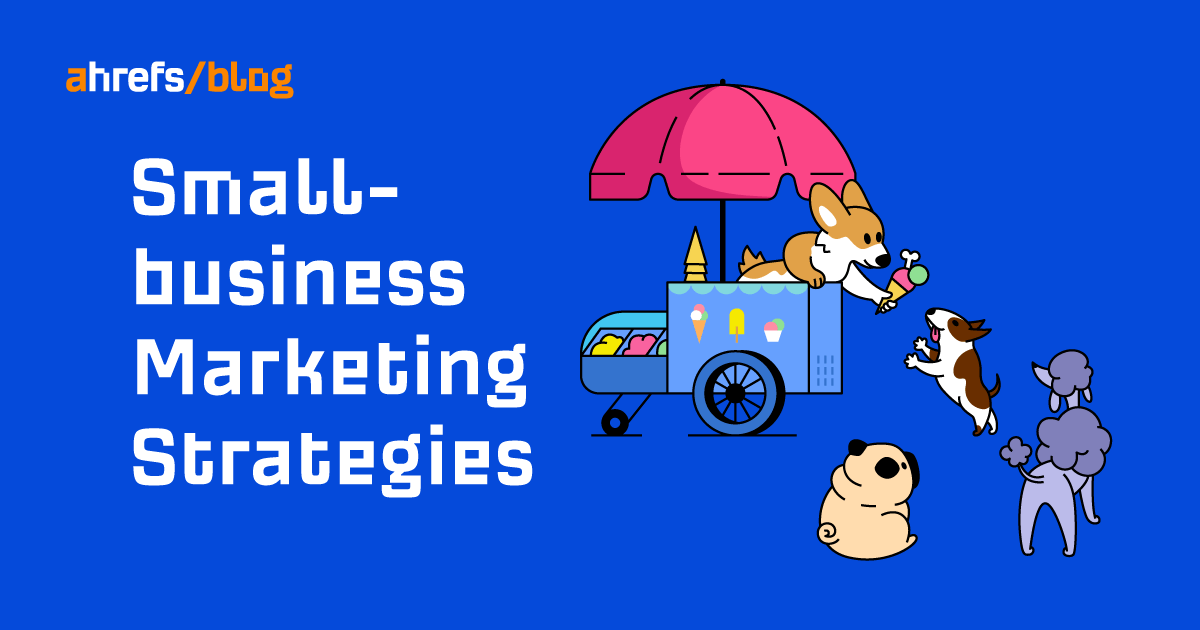
Looking for a good marketing strategy that won’t break the bank?
Call them strategies or tactics, but here are 14 ways you can promote your business that a) work, b) don’t require a large budget, and c) won’t hurt your brand in the long run.
Before pouring resources into any promotion strategies, make sure your clients are happy with your product or service. Otherwise, you may end up with the leaky bucket effect.

The leaky bucket effect is when you spend resources to bring people to your website, but they don’t perform any action on it and don’t come back.
Usually, it happens when businesses focus only on promotion and forget about the value their offer brings the customer.
Of course, you’ll never be able to turn 100% of website visitors into customers. However, when you’re starting to notice none of your marketing tactics bring results, you need to introduce changes to either how you drive traffic to the website, your pricing, or even what you offer.
This is your chance to ask your customers what they like and what can be improved. You can use that data to improve your marketing communications or even your product because, chances are, other people will like/dislike the same things.
Also, as you start talking with your customers, you may even come across candidates for brand ambassadors.
How to get started
Reach for some basic market research tools:
- Surveys – Can be performed 100% online for free with tools like Google Forms or Survicate. You can use them for measuring customer satisfaction.
- Interviews – Allow for face-to-face discussions. Can be performed even without a predefined structure. Often used for exploratory purposes.
- Internal data – Draw conclusions from reported issues and online reviews. If possible, interview your customer-facing employees.
Recommended reading: How to Achieve Product-Market Fit (5 Steps)
In case you haven’t created/claimed your Google Business Profile yet, make sure you do. It’s one of the most important marketing tools for small businesses operating locally.
Google Business Profile makes your business visible to potential customers in your vicinity in three ways:
1. Google Map Pack:

2. Google Maps:

3. Local knowledge panel (when the search query includes your brand’s name):

How to get started
Create or claim (option for already created GBPs) your Google Business Profile for free here.
And to make sure your profile is optimized, you can read our guide on the topic.
We’re talking about websites that offer listings of businesses like yours, providing basic information like address, operating hours, contact information, website, etc.
Some directories are free; others are paid. But you may want to consider even the paid ones because directories give you three significant benefits:
- It’s the quickest way to get your business to the first page of Google for competitive keywords.
- Your business will show up in search results of those directories.
- Citations (mentions of your business) in local directories can increase your chances of showing up in the Google Map Pack.

How to get started
List your business, starting from:
- Big data aggregators like Express Update and Neustar Localeze.
- Core platforms like Facebook, Bing Places, Apple Maps, and Better Business Bureau.
- Industry and local sites relevant to your business (e.g., FindLaw for lawyers, Tripadvisor for hotels).
You can list your business manually or use a submission service to manage your citations from one place. You can also see where your competitors got their citations and go after the same ones.
Two resources that will help you in this process:
According to a study by BrightLocal, 91% of people regularly or occasionally read online reviews, and 84% trust online reviews as much as a personal recommendation.
And it makes sense when you think about it. When dozens of people have tried a product before you, it’s hard to completely ignore their opinions.
Moreover, positive reviews can impact rankings in the Google Map Pack.

How to get started
Ask your customers to leave online reviews and try to answer all of them (good or bad). This will show existing and potential customers that you really care.
You can ask for reviews whenever you get a chance to contact your customers (personally, via email, via text message, in a thank-you note after purchase, etc.). But you can also use tools for generating reviews like this one from Google.

You can easily find online tools for managing your reviews. Some examples are Grade.us, ReviewPush, etc.
SEO content is any kind of content designed to rank in search engines.
When your content ranks, it can drive consistent, organic search traffic without any additional costs. That’s when you tap into search demand.

The basis of this strategy is finding relevant keywords with traffic potential. The more relevant the keywords, the higher the chance that the traffic you get will convert into sales or other forms of engagement you need.

It’s good to keep in mind that even when you rank #1, it’s not forever. You may need to revisit your content and update it when your rankings drop.
How to get started
First, determine if SEO content is right for your business. This is the case if the answer to at least one of the below questions is yes:
- Are people looking online for what you sell or do?
- Are people looking online for solutions to problems your business helps to solve?
You can answer that using a keyword tool. You can use our free keyword generator to look up keywords that pop into your mind. You can even check their search demand in different countries and four different search engines.

Once you determine that SEO is worth it for you, use our detailed step-by-step guide on creating SEO content.
Selling something that looks good in a photo or video?
Ask your customers to share a picture or a short video featuring your product. Happy customers create more happy customers.

How to get started
Saying something as plain as “share your photo with us” may not be enough.
You can encourage more user-generated content (UGC) when you make your request more exciting or offer something in return.
For example, brands like Vans or Apple launched an official hashtag for users and fans. Sharing photos under those hashtags creates a feeling of being part of something bigger and gives people a chance to pay attention to them.

Brands, such as clothing company Pakker Trousers, launch contests where people can win stuff for sharing a photo of themselves using the product.

Sharing a free resource can attract visitors and give them a taste of your offer. Think ebooks, product samples, online calculators, free courses, free consultations, and so on.

If your business relies on direct contact or has a long sales cycle, you can ask for contact information in return for your free resource. This type of marketing tool is called a lead magnet.

How to get started
Start with choosing a proven topic for your free resource.
One of the methods is doing keyword research. Not only will you know what actually interests people, but you’ll also have a chance to rank for relevant keywords and drive organic traffic to your resource for free.
Here’s how you can do it in Ahrefs’ Keywords Explorer:
- Plug in a topic or thing relevant to your business
- Go to the Matching terms report
- Limit the results to some popular resource types, e.g., a calculator
- Sort and filter results based on provided SEO metrics, such as search volume, Keyword Difficulty (KD), or Traffic Potential (TP)

You can also find proven topics by analyzing your competitors and studying your niche. See this guide for details.
Video marketing is especially good for two things:
- It helps to attract customers – 70% of viewers bought from a brand after seeing it on YouTube (Google).
- It helps to educate your audience – 96% of people have watched an explainer video to learn more about a product or service (Wyzowl).
And if you combine video blogging with SEO, you get a highly engaging content format with free distribution.

How to get started
Find video topic ideas with search demand:
- Go to Ahrefs’ Site Explorer and paste “youtube.com” as the URL
- Go to the Organic keywords report
- In the keyword filter, insert relevant keyword(s) for your business and hit “Apply”

From that point, you can adjust the filters and sort the results to fine-tune your research.
Let’s move one step back because video blogging is not something everybody “feels” like doing.
Equipment cost, talent, and a language barrier. These are some common objections to doing video marketing. But based on our experience, they are not deal breakers. Here’s what our video marketing master has to say about that:
Recommended viewing: YouTube SEO: How to Rank YouTube Videos #1
Sometimes, you don’t need to create new content to get more traffic.
Your old content may just need an SEO “do-over.”

How to get started
You need to find a good candidate for the do-over. Not every page will be a good fit.
To do this, you will need two things:
- This guide – Go ahead and try everything from this guide, from improving the click-through rate of your top-performing content to going after featured snippets.
- SEO tools – Data on keywords and backlinks from your and your competitors’ sites can come from a tool like Ahrefs’ Site Audit. And data on your click-through rates from search engines will need to come from a tool specific to the search engine. For Google, this will be Google Search Console. For Bing, it’s Bing Webmaster Tools.
Repurposing content is about taking existing content and “repacking” it for other marketing channels.
This simple technique allows you to reach a wider audience without the need to create new content from scratch.
So for example, a blog post can become a video, or a course, or a series of social media posts, and so on and vice versa.

How to get started
You can take your best-performing content and repurpose it for other marketing channels. If it worked in one place, it probably would in other places too.
Sometimes, you can repurpose content that didn’t perform well in the past (but you have reasons to think it will work elsewhere). For example, you can take your unique, quality articles that just didn’t get enough backlinks to challenge fierce competition on the SERPs and share them in a different format on social media platforms.


For the above techniques, follow our full guide on content repurposing.
Chances are, your target audience is similar to other websites’ existing target audience. And that’s a good thing.
You may reach somebody else’s audience with your message through:
- Getting featured in podcasts and newsletters.
- Guest blogging.
- Getting featured in relevant rankings and reviews.

Except for newsletters (without a web format), all of the above are also opportunities for getting a direct link to your website—which may help boost your SEO. And even being featured in a newsletter may indirectly lead to links from newsletter subscribers.
How to get started
Method 1. Use Google with search operators to find opportunities
Helpful operators here are: “AND”, “OR”. You can use them to find websites that meet complex queries instead of just one keyword.

Then, click through the results, find websites that look like a good fit for your business, and pitch to them.
Method 2. Use Ahrefs to find opportunities and get instant performance data
Ahrefs’ SEO Toolbar allows you to see performance data of websites as you Google them. So the Google screenshot from above turns into this:

This way, you can easily filter out websites that don’t get traffic or whose links have the lowest chance of impacting your SEO.
Another method is to see where other websites, such as your competitors, got their links from. This works for any kind of mentions that leaves a trace of a backlink: reviews, rankings, guest blogging, and PR (more on that in the next chapter).
- Go to Site Explorer and paste a URL you want to screen
- Go to the Backlinks report
- Search for the kind of backlinks you want to go after; to illustrate, for guest articles, use “Anchor with surrounding text” filter and type the word “author”

Then you can pitch the same website with a personalized and relevant message.
Public relations is not reserved for big brands with entire PR departments on the payroll. Small businesses can get press too. And they can get it for free.

There are basically two ways to get free press.
One is to do something extraordinary (maybe your business is already doing it?) and issue a press release about it.
The other is to offer your expert commentary, per the journalist’s request.
It can take some effort, but it’s usually worth it:
- PR increases brand awareness.
- News websites and magazines can drive traffic to your website.
- Being featured by the press is a great chance to earn a link from a high-authority website (and boost SEO).

How to get started
If you feel your business is doing something that can make the headlines, tell the press about it.
Use this guide to write a press release and send it to the magazines where the story is most relevant.
An effective tactic may be to start with reputable local media. If your story gets featured, you may use it in your pitch to more prominent media outlets. Additionally, other media may pick up the story organically.
As for monitoring journalist requests, use:
- A service like HARO, Terkel, or SourceBottle.
- #journorequest on Twitter.
These two free tools from Ahrefs can come in handy too:
- Our free website authority checker will show you the Domain Rating (DR) for any given website. DR is a good proxy for checking the authority of the website and the possible SEO impact of links from it.
- Ahrefs Webmaster Tools will show all backlinks you got from PR efforts, among other features.
Recommended reading: Digital PR: The Beginner’s Guide to Making Your Brand Unmissable
Affiliate marketing programs allow influencers, bloggers, and other kinds of online content creators to promote your products for a commission from sales.
You can find affiliate marketing examples all over the web. Usually, affiliate marketers include links to products inside reviews or some kind of educational content (recipes, tutorials, etc.). Sometimes, they even run their own shops.

Affiliate marketing is designed to be mutually beneficial. The better affiliates promote, the more you sell, and the more they earn in return.
How to get started
Depends on the affiliate marketing program.
For example, on ClickBank, you list your product on a public marketplace and wait for affiliates to find you.
But on platforms like Impact, you can choose affiliates from the platform’s contact list.
But if you want to spend the least possible time on managing your affiliate program, you can consider a program like GiddyUp. It will even take care of creating banners for you and your affiliates.
As for the costs, there are usually some small up-front costs paid to the affiliate platform. But other than that, everything is performance-based.
The oldest advice on the planet, right? Well, it still works.
While following your competitor’s steps may be harder in the “offline” world, it’s much easier (and cheaper) online.
By using competitor analysis tools, you can learn things like:
- What type of content works for your competition.
- What do competitors see as a good advertising investment and how they advertise it.
- Where they get their backlinks.
- Gaps in your content strategy.
How to get started
Get a competitor analysis tool designed for the type of marketing you want to analyze. Some examples are:
- Ahrefs – SEO, PPC, and content marketing
- Moat – Digital ads
- MailCharts – Email marketing
- Brand24 – Brand monitoring in web and social media
- SparkToro – Audience insight
- Visualping – Webpage monitoring
So say you want to see which topics you haven’t blogged about yet compared to your competitors. You can check that quickly by pasting your and your competitors’ URLs in Ahrefs’ Content Gap tool.

You’ll get keywords your competitors rank for, but you don’t. This way, you’ll save a ton of time on manually going through websites.
Recommended reading: How to Conduct a Competitive Analysis (Template Included)
What is the best marketing strategy for a small business?
The best marketing strategy is the one that brings you results. It’s common to see some strategies working for some and not for others.
Although it may sound cliche, it’s crucial to take any advice with a grain of salt and simply test things yourself. The best marketing strategy may be the one you haven’t tried yet.
And when you find a marketing strategy that works for you, double down on it.
Final thoughts
As you can see, marketing strategies can be very different from one another. It’s actually kind of mind-boggling to see so many ways of growing a business.
So a good idea is to prioritize.
Try the classic “prioritization matrix.” Take a moment to think about marketing strategies you found in this and other guides and put them in one of the categories based on a) the effort they need and b) the value they give.

So for example, if getting free press may be low effort and high value for you, that will be something to put into action as soon as possible.
Got questions? Ping me on Twitter.
SEO
Why Google Can’t Tell You About Every Ranking Drop

In a recent Twitter exchange, Google’s Search Liaison, Danny Sullivan, provided insight into how the search engine handles algorithmic spam actions and ranking drops.
The discussion was sparked by a website owner’s complaint about a significant traffic loss and the inability to request a manual review.
Sullivan clarified that a site could be affected by an algorithmic spam action or simply not ranking well due to other factors.
He emphasized that many sites experiencing ranking drops mistakenly attribute it to an algorithmic spam action when that may not be the case.
“I’ve looked at many sites where people have complained about losing rankings and decide they have a algorithmic spam action against them, but they don’t. “
Sullivan’s full statement will help you understand Google’s transparency challenges.
Additionally, he explains why the desire for manual review to override automated rankings may be misguided.
Two different things. A site could have an algorithmic spam action. A site could be not ranking well because other systems that *are not about spam* just don’t see it as helpful.
I’ve looked at many sites where people have complained about losing rankings and decide they have a…
— Google SearchLiaison (@searchliaison) May 13, 2024
Challenges In Transparency & Manual Intervention
Sullivan acknowledged the idea of providing more transparency in Search Console, potentially notifying site owners of algorithmic actions similar to manual actions.
However, he highlighted two key challenges:
- Revealing algorithmic spam indicators could allow bad actors to game the system.
- Algorithmic actions are not site-specific and cannot be manually lifted.
Sullivan expressed sympathy for the frustration of not knowing the cause of a traffic drop and the inability to communicate with someone about it.
However, he cautioned against the desire for a manual intervention to override the automated systems’ rankings.
Sullivan states:
“…you don’t really want to think “Oh, I just wish I had a manual action, that would be so much easier.” You really don’t want your individual site coming the attention of our spam analysts. First, it’s not like manual actions are somehow instantly processed. Second, it’s just something we know about a site going forward, especially if it says it has change but hasn’t really.”
Determining Content Helpfulness & Reliability
Moving beyond spam, Sullivan discussed various systems that assess the helpfulness, usefulness, and reliability of individual content and sites.
He acknowledged that these systems are imperfect and some high-quality sites may not be recognized as well as they should be.
“Some of them ranking really well. But they’ve moved down a bit in small positions enough that the traffic drop is notable. They assume they have fundamental issues but don’t, really — which is why we added a whole section about this to our debugging traffic drops page.”
Sullivan revealed ongoing discussions about providing more indicators in Search Console to help creators understand their content’s performance.
“Another thing I’ve been discussing, and I’m not alone in this, is could we do more in Search Console to show some of these indicators. This is all challenging similar to all the stuff I said about spam, about how not wanting to let the systems get gamed, and also how there’s then no button we would push that’s like “actually more useful than our automated systems think — rank it better!” But maybe there’s a way we can find to share more, in a way that helps everyone and coupled with better guidance, would help creators.”
Advocacy For Small Publishers & Positive Progress
In response to a suggestion from Brandon Saltalamacchia, founder of RetroDodo, about manually reviewing “good” sites and providing guidance, Sullivan shared his thoughts on potential solutions.
He mentioned exploring ideas such as self-declaration through structured data for small publishers and learning from that information to make positive changes.
“I have some thoughts I’ve been exploring and proposing on what we might do with small publishers and self-declaring with structured data and how we might learn from that and use that in various ways. Which is getting way ahead of myself and the usual no promises but yes, I think and hope for ways to move ahead more positively.”
Sullivan said he can’t make promises or implement changes overnight, but he expressed hope for finding ways to move forward positively.
Featured Image: Tero Vesalainen/Shutterstock
SEO
56 Google Search Statistics to Bookmark for 2024
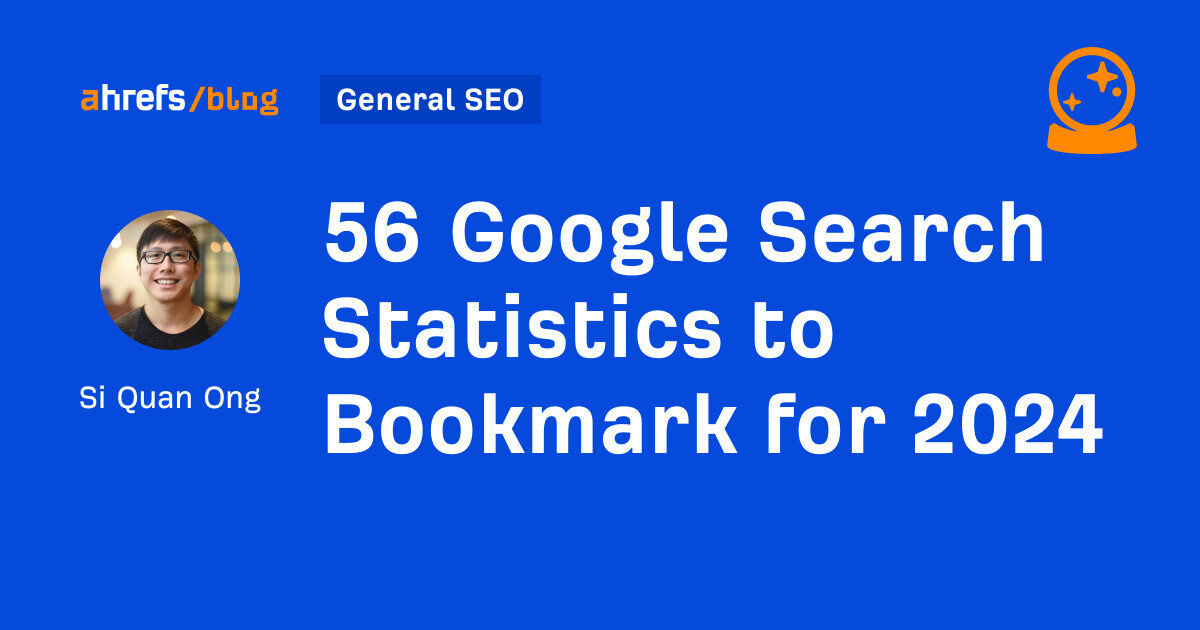
If you’re curious about the state of Google search in 2024, look no further.
Each year we pick, vet, and categorize a list of up-to-date statistics to give you insights from trusted sources on Google search trends.
- Google has a web index of “about 400 billion documents”. (The Capitol Forum)
- Google’s search index is over 100 million gigabytes in size. (Google)
- There are an estimated 3.5 billion searches on Google each day. (Internet Live Stats)
- 61.5% of desktop searches and 34.4% of mobile searches result in no clicks. (SparkToro)
- 15% of all Google searches have never been searched before. (Google)
- 94.74% of keywords get 10 monthly searches or fewer. (Ahrefs)
- The most searched keyword in the US and globally is “YouTube,” and youtube.com gets the most traffic from Google. (Ahrefs)
- 96.55% of all pages get zero search traffic from Google. (Ahrefs)
- 50-65% of all number-one spots are dominated by featured snippets. (Authority Hacker)
- Reddit is the most popular domain for product review queries. (Detailed)
- Google is the most used search engine in the world, with a mobile market share of 95.32% and a desktop market share of 81.95%. (Statista)
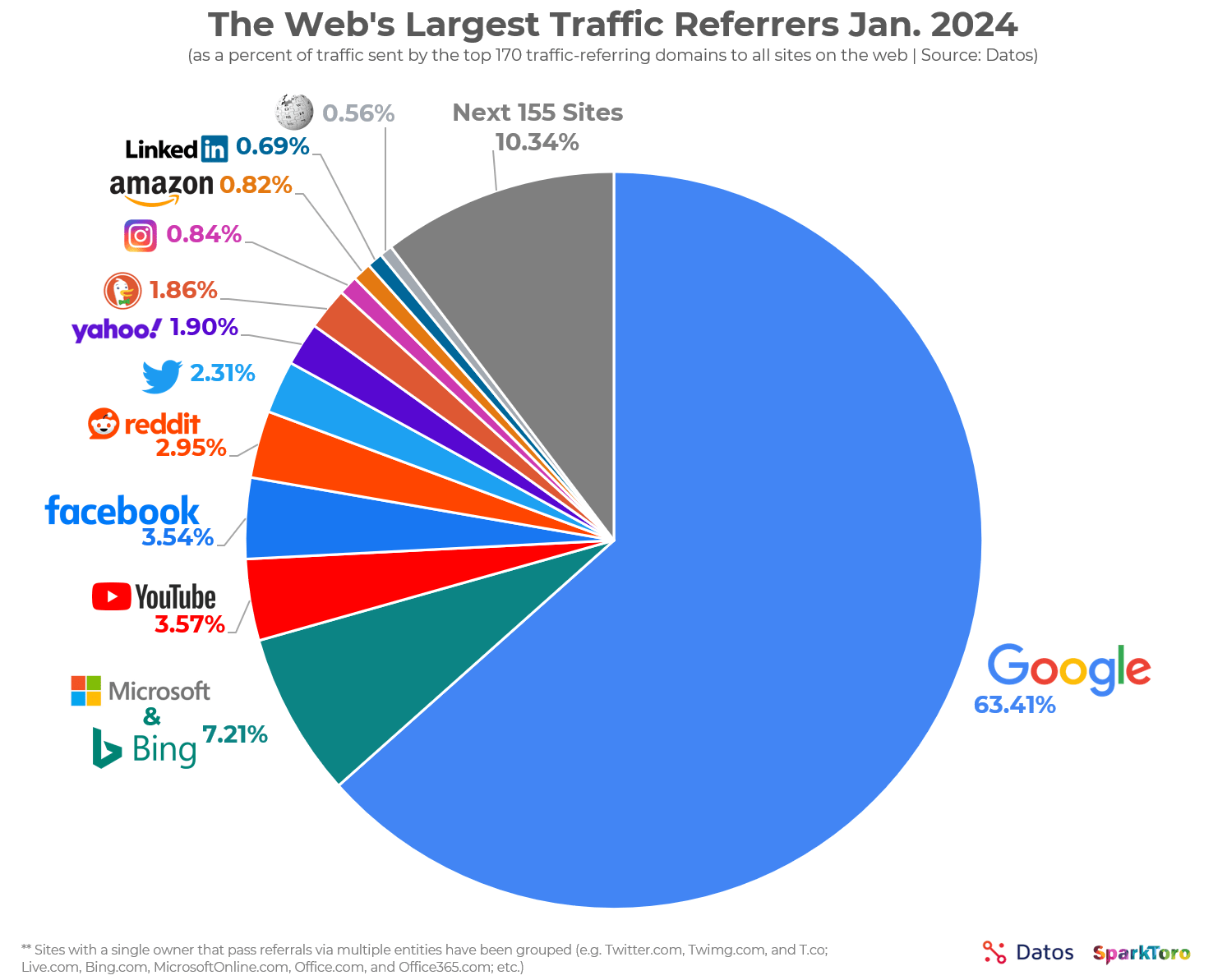

- Google.com generated 84.2 billion visits a month in 2023. (Statista)
- Google generated $307.4 billion in revenue in 2023. (Alphabet Investor Relations)
- 63.41% of all US web traffic referrals come from Google. (SparkToro)
- 92.96% of global traffic comes from Google Search, Google Images, and Google Maps. (SparkToro)
- Only 49% of Gen Z women use Google as their search engine. The rest use TikTok. (Search Engine Land)
- 58.67% of all website traffic worldwide comes from mobile phones. (Statista)
- 57% of local search queries are submitted using a mobile device or tablet. (ReviewTrackers)
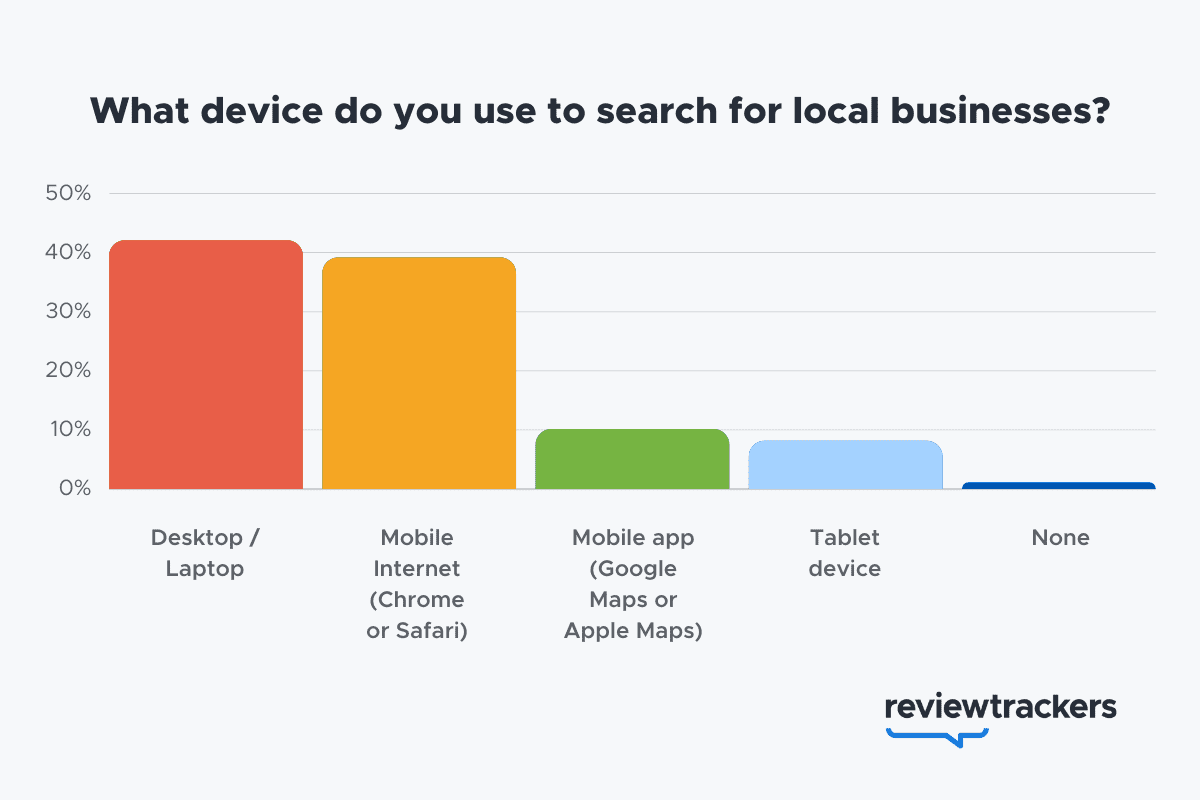

- 51% of smartphone users have discovered a new company or product when conducting a search on their smartphones. (Think With Google)
- 54% of smartphone users search for business hours, and 53% search for directions to local stores. (Think With Google)
- 18% of local searches on smartphones lead to a purchase within a day vs. 7% of non-local searches. (Think With Google)
- 56% of in-store shoppers used their smartphones to shop or research items while they were in-store. (Think With Google)
- 60% of smartphone users have contacted a business directly using the search results (e.g., “click to call” option). (Think With Google)
- 63.6% of consumers say they are likely to check reviews on Google before visiting a business location. (ReviewTrackers)
- 88% of consumers would use a business that replies to all of its reviews. (BrightLocal)
- Customers are 2.7 times more likely to consider a business reputable if they find a complete Business Profile on Google Search and Maps. (Google)
- Customers are 70% more likely to visit and 50% more likely to consider purchasing from businesses with a complete Business Profile. (Google)
- 76% of people who search on their smartphones for something nearby visit a business within a day. (Think With Google)
- 28% of searches for something nearby result in a purchase. (Think With Google)
- Mobile searches for “store open near me” (such as, “grocery store open near me” have grown by over 250% in the last two years. (Think With Google)
- People use Google Lens for 12 billion visual searches a month. (Google)
- 50% of online shoppers say images helped them decide what to buy. (Think With Google)
- There are an estimated 136 billion indexed images on Google Image Search. (Photutorial)
- 15.8% of Google SERPs show images. (Moz)
- People click on 3D images almost 50% more than static ones. (Google)
- More than 800 million people use Google Discover monthly to stay updated on their interests. (Google)
- 46% of Google Discover URLs are news sites, 44% e-commerce, 7% entertainment, and 2% travel. (Search Engine Journal)
- Even though news sites accounted for under 50% of Google Discover URLs, they received 99% of Discover clicks. (Search Engine Journal)
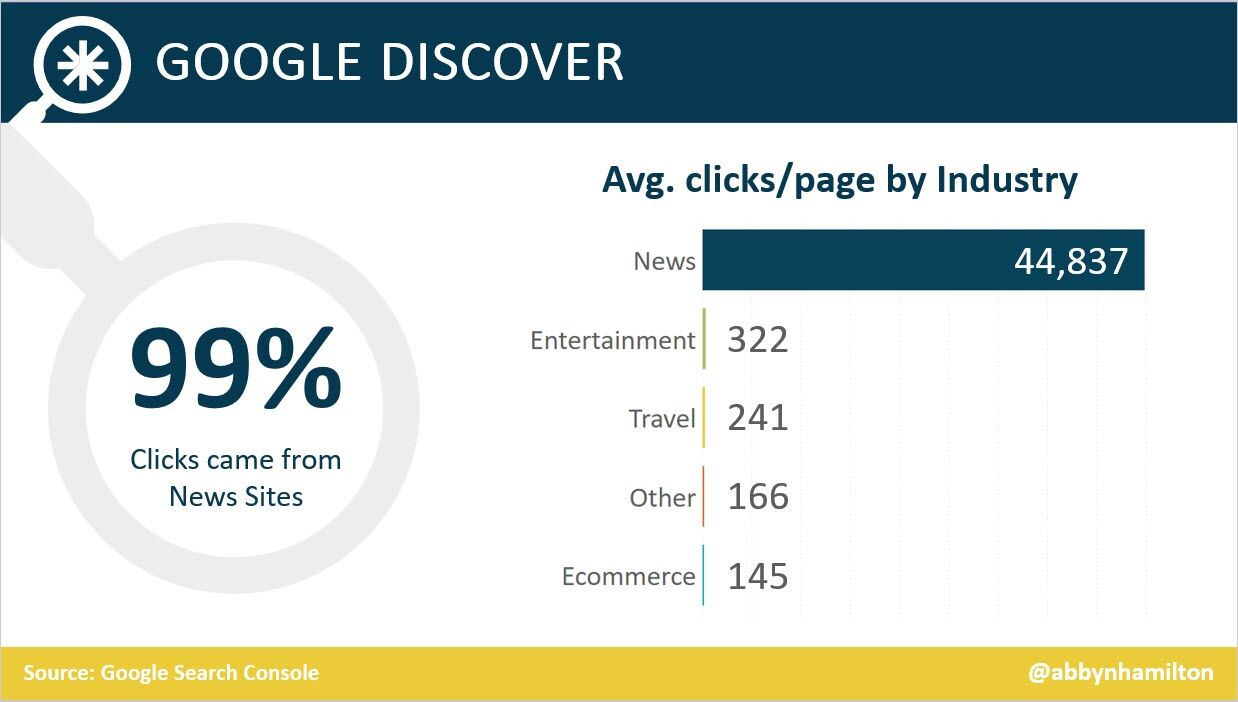

- Most Google Discover URLs only receive traffic for three to four days, with most of that traffic occurring one to two days after publishing. (Search Engine Journal)
- The clickthrough rate (CTR) for Google Discover is 11%. (Search Engine Journal)
- 91.45% of search volumes in Google Ads Keyword Planner are overestimates. (Ahrefs)
- For every $1 a business spends on Google Ads, they receive $8 in profit through Google Search and Ads. (Google)
- Google removed 5.5 billion ads, suspended 12.7 million advertiser accounts, restricted over 6.9 billion ads, and restricted ads from showing up on 2.1 billion publisher pages in 2023. (Google)
- The average shopping click-through rate (CTR) across all industries is 0.86% for Google Ads. (Wordstream)
- The average shopping cost per click (CPC) across all industries is $0.66 for Google Ads. (Wordstream)
- The average shopping conversion rate (CVR) across all industries is 1.91% for Google Ads. (Wordstream)
- 58% of consumers ages 25-34 use voice search daily. (UpCity)
- 16% of people use voice search for local “near me” searches. (UpCity)
- 67% of consumers say they’re very likely to use voice search when seeking information. (UpCity)
- Active users of the Google Assistant grew 4X over the past year, as of 2019. (Think With Google)
- Google Assistant hit 1 billion app installs. (Android Police)
- AI-generated answers from SGE were available for 91% of entertainment queries but only 17% of healthcare queries. (Statista)
- The AI-generated answers in Google’s Search Generative Experience (SGE) do not match any links from the top 10 Google organic search results 93.8% of the time. (Search Engine Journal)
- Google displays a Search Generative element for 86.8% of all search queries. (Authoritas)


- 62% of generative links came from sources outside the top 10 ranking organic domains. Only 20.1% of generative URLs directly match an organic URL ranking on page one. (Authoritas)
- 70% of SEOs said that they were worried about the impact of SGE on organic search (Aira)
Learn more
Check out more resources on how Google works:
SEO
How To Use ChatGPT For Keyword Research

Anyone not using ChatGPT for keyword research is missing a trick.
You can save time and understand an entire topic in seconds instead of hours.
In this article, I outline my most effective ChatGPT prompts for keyword research and teach you how I put them together so that you, too, can take, edit, and enhance them even further.
But before we jump into the prompts, I want to emphasize that you shouldn’t replace keyword research tools or disregard traditional keyword research methods.
ChatGPT can make mistakes. It can even create new keywords if you give it the right prompt. For example, I asked it to provide me with a unique keyword for the topic “SEO” that had never been searched before.
“Interstellar Internet SEO: Optimizing content for the theoretical concept of an interstellar internet, considering the challenges of space-time and interplanetary communication delays.”
Although I want to jump into my LinkedIn profile and update my title to “Interstellar Internet SEO Consultant,” unfortunately, no one has searched that (and they probably never will)!
You must not blindly rely on the data you get back from ChatGPT.
What you can rely on ChatGPT for is the topic ideation stage of keyword research and inspiration.
ChatGPT is a large language model trained with massive amounts of data to accurately predict what word will come next in a sentence. However, it does not know how to do keyword research yet.
Instead, think of ChatGPT as having an expert on any topic armed with the information if you ask it the right question.
In this guide, that is exactly what I aim to teach you how to do – the most essential prompts you need to know when performing topical keyword research.
Best ChatGPT Keyword Research Prompts
The following ChatGPT keyword research prompts can be used on any niche, even a topic to which you are brand new.
For this demonstration, let’s use the topic of “SEO” to demonstrate these prompts.
Generating Keyword Ideas Based On A Topic
What Are The {X} Most Popular Sub-topics Related To {Topic}?
The first prompt is to give you an idea of the niche.
As shown above, ChatGPT did a great job understanding and breaking down SEO into three pillars: on-page, off-page & technical.
The key to the following prompt is to take one of the topics ChatGPT has given and query the sub-topics.
What Are The {X} Most Popular Sub-topics Related To {Sub-topic}?
For this example, let’s query, “What are the most popular sub-topics related to keyword research?”
Having done keyword research for over 10 years, I would expect it to output information related to keyword research metrics, the types of keywords, and intent.
Let’s see.
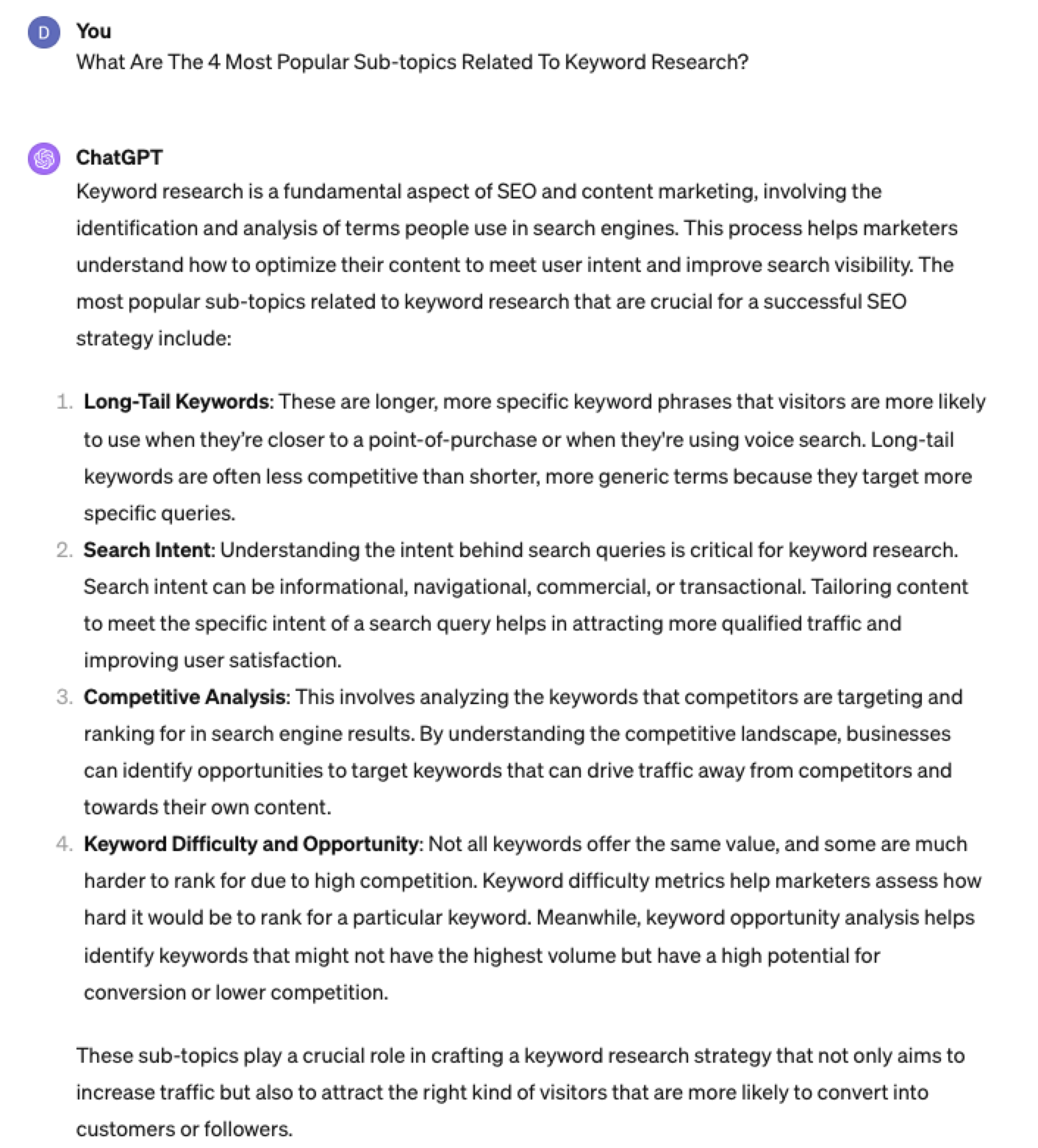 Screenshot from ChatGPT 4, April 2024
Screenshot from ChatGPT 4, April 2024Again, right on the money.
To get the keywords you want without having ChatGPT describe each answer, use the prompt “list without description.”
Here is an example of that.
List Without Description The Top {X} Most Popular Keywords For The Topic Of {X}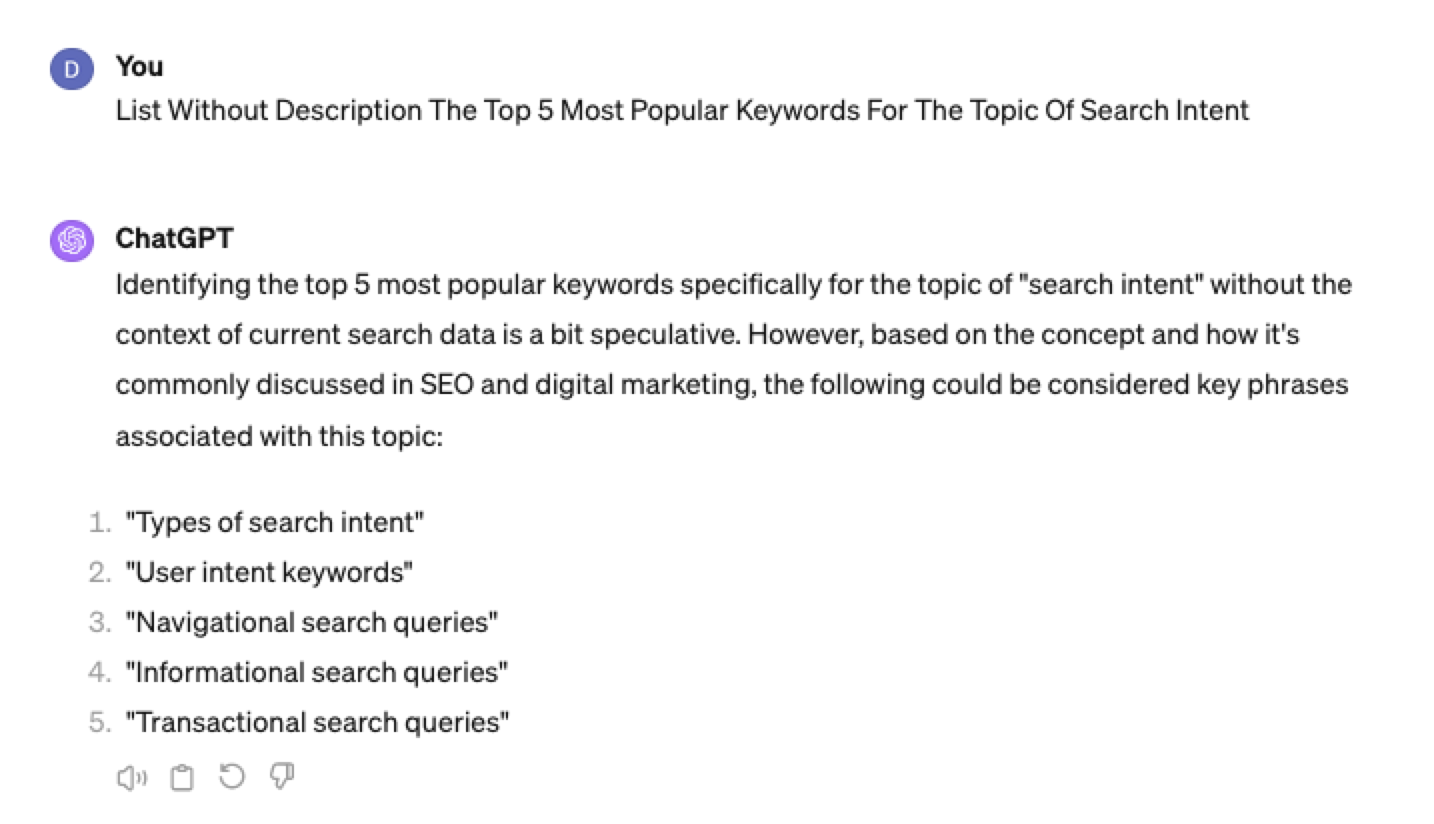
You can even branch these keywords out further into their long-tail.
Example prompt:
List Without Description The Top {X} Most Popular Long-tail Keywords For The Topic “{X}”
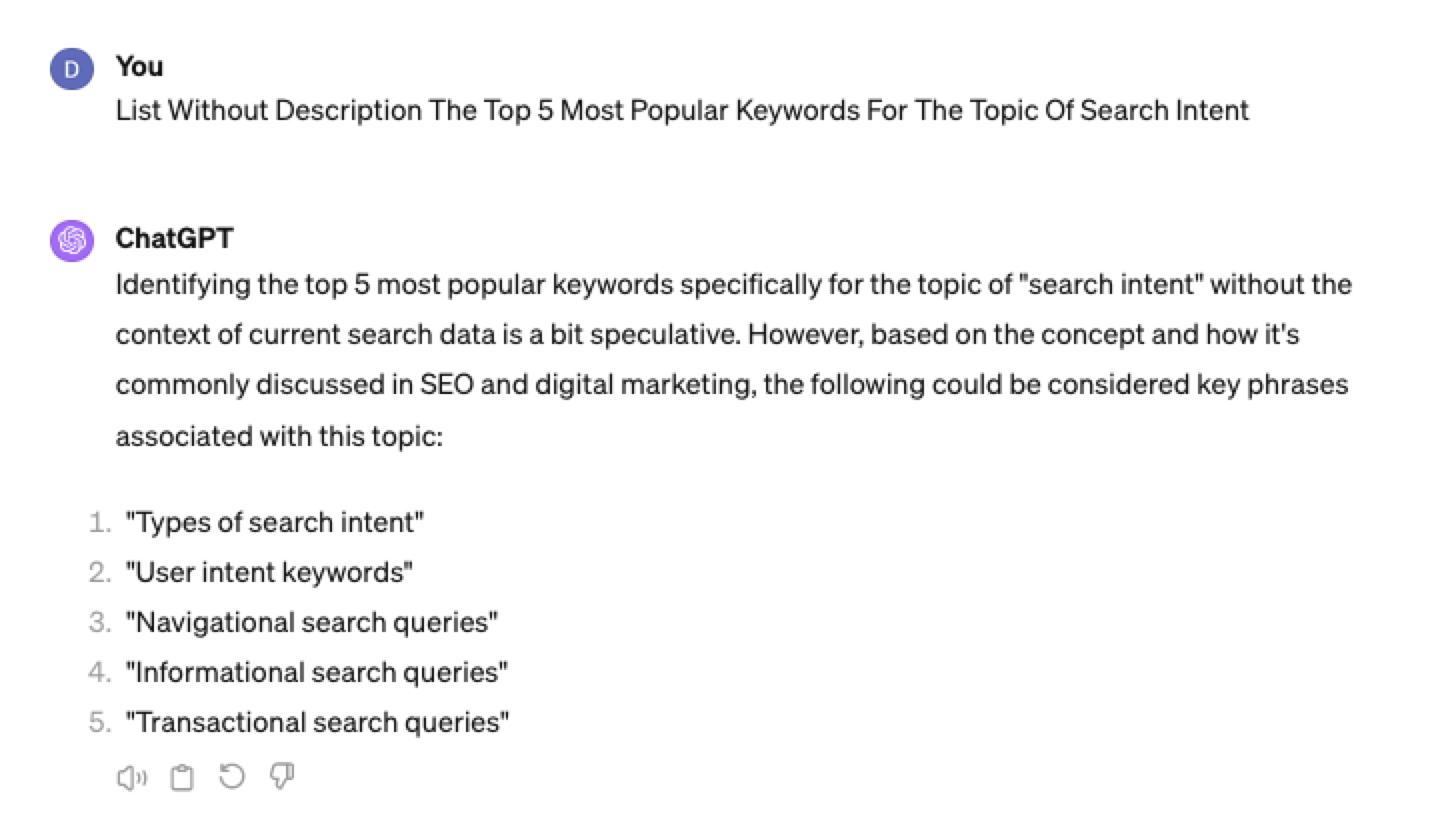 Screenshot ChatGPT 4,April 2024
Screenshot ChatGPT 4,April 2024List Without Description The Top Semantically Related Keywords And Entities For The Topic {X}
You can even ask ChatGPT what any topic’s semantically related keywords and entities are!
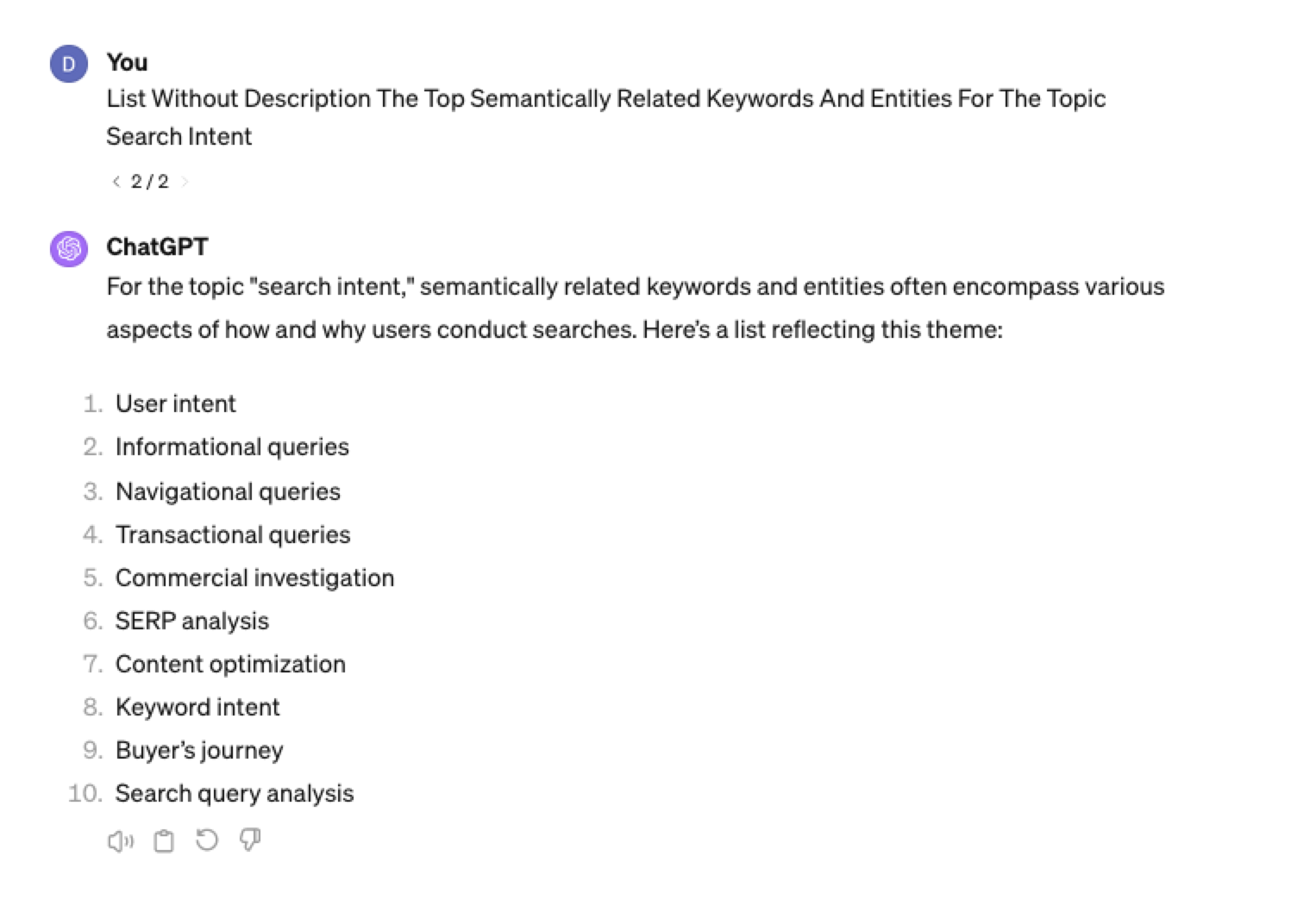 Screenshot ChatGPT 4, April 2024
Screenshot ChatGPT 4, April 2024Tip: The Onion Method Of Prompting ChatGPT
When you are happy with a series of prompts, add them all to one prompt. For example, so far in this article, we have asked ChatGPT the following:
- What are the four most popular sub-topics related to SEO?
- What are the four most popular sub-topics related to keyword research
- List without description the top five most popular keywords for “keyword intent”?
- List without description the top five most popular long-tail keywords for the topic “keyword intent types”?
- List without description the top semantically related keywords and entities for the topic “types of keyword intent in SEO.”
Combine all five into one prompt by telling ChatGPT to perform a series of steps. Example:
“Perform the following steps in a consecutive order Step 1, Step 2, Step 3, Step 4, and Step 5”
Example:
“Perform the following steps in a consecutive order Step 1, Step 2, Step 3, Step 4 and Step 5. Step 1 – Generate an answer for the 3 most popular sub-topics related to {Topic}?. Step 2 – Generate 3 of the most popular sub-topics related to each answer. Step 3 – Take those answers and list without description their top 3 most popular keywords. Step 4 – For the answers given of their most popular keywords, provide 3 long-tail keywords. Step 5 – for each long-tail keyword offered in the response, a list without descriptions 3 of their top semantically related keywords and entities.”
Generating Keyword Ideas Based On A Question
Taking the steps approach from above, we can get ChatGPT to help streamline getting keyword ideas based on a question. For example, let’s ask, “What is SEO?”
“Perform the following steps in a consecutive order Step 1, Step 2, Step 3, and Step 4. Step 1 Generate 10 questions about “{Question}”?. Step 2 – Generate 5 more questions about “{Question}” that do not repeat the above. Step 3 – Generate 5 more questions about “{Question}” that do not repeat the above. Step 4 – Based on the above Steps 1,2,3 suggest a final list of questions avoiding duplicates or semantically similar questions.”
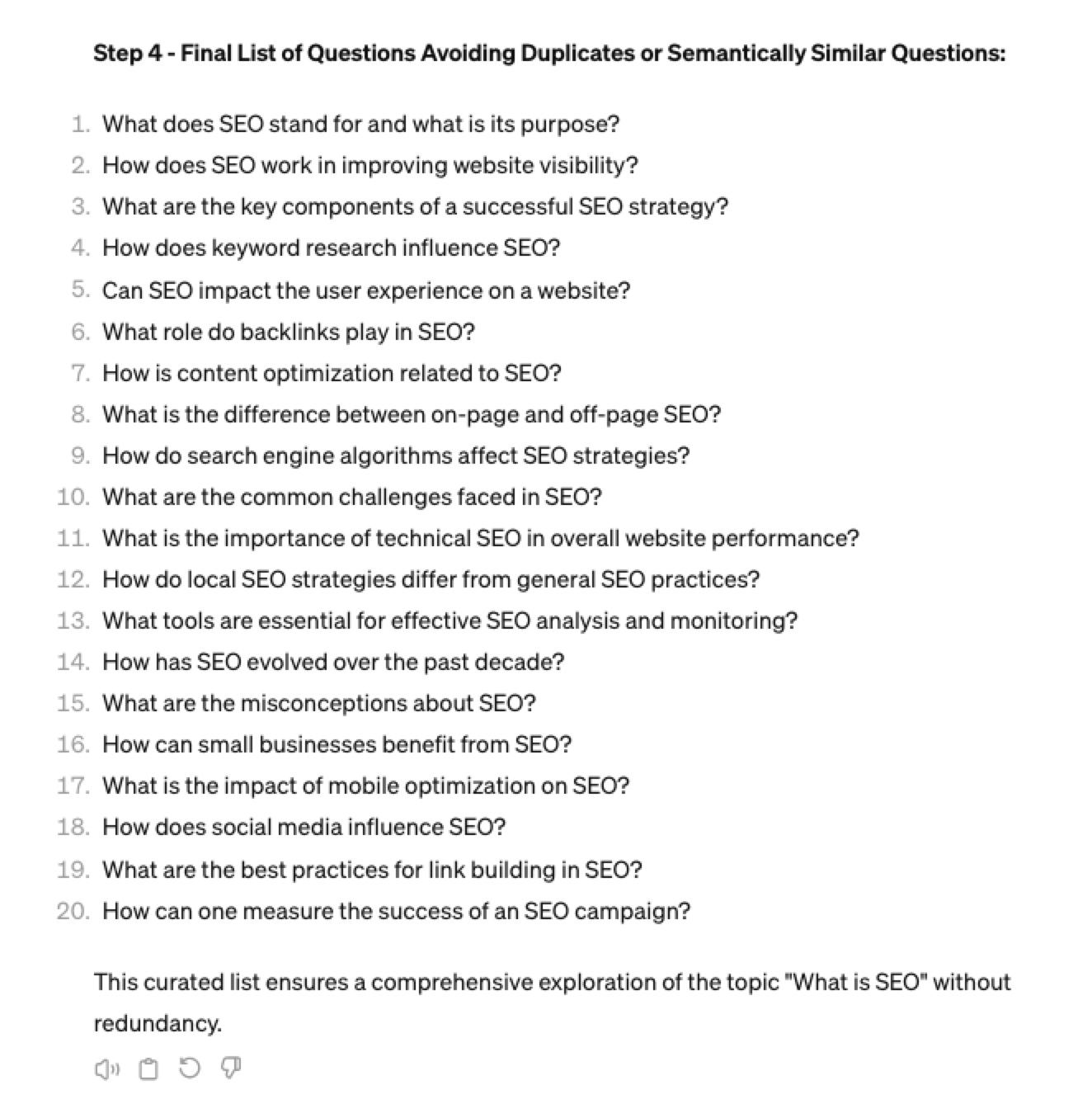 Screenshot ChatGPT 4, April 2024
Screenshot ChatGPT 4, April 2024Generating Keyword Ideas Using ChatGPT Based On The Alphabet Soup Method
One of my favorite methods, manually, without even using a keyword research tool, is to generate keyword research ideas from Google autocomplete, going from A to Z.
-
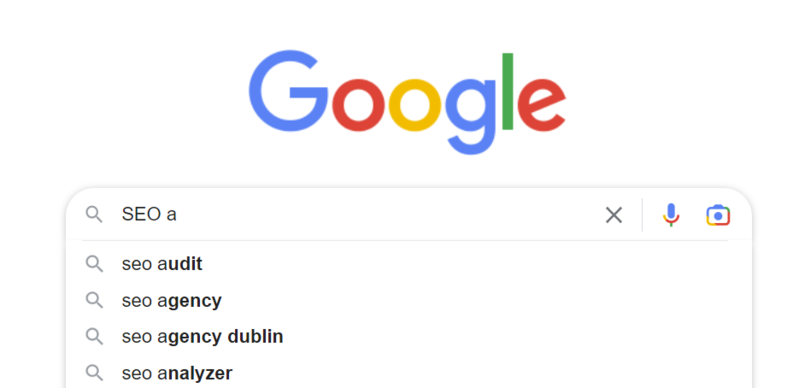 Screenshot from Google autocomplete, April 2024
Screenshot from Google autocomplete, April 2024
You can also do this using ChatGPT.
Example prompt:
“give me popular keywords that includes the keyword “SEO”, and the next letter of the word starts with a”
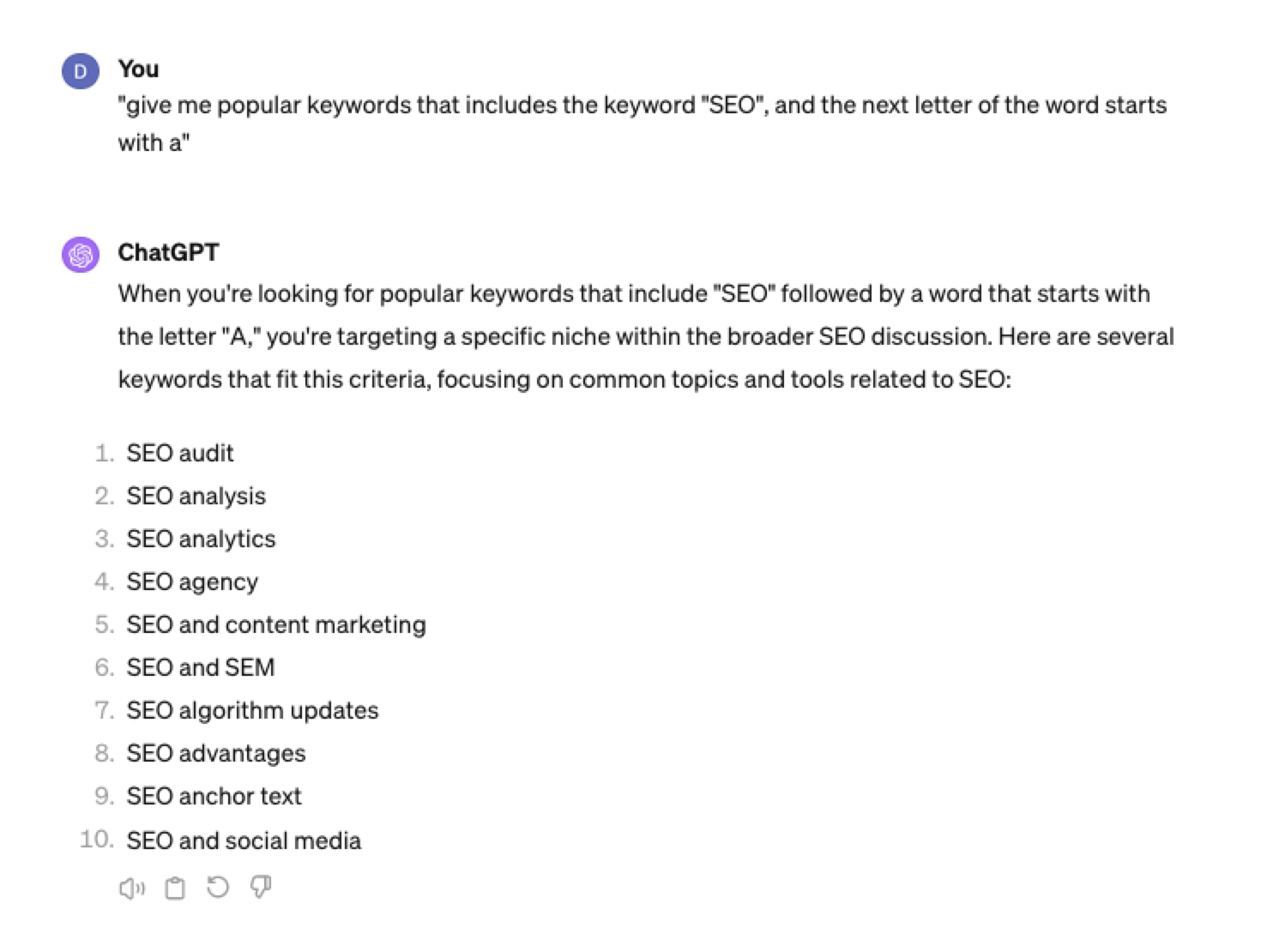 Screenshot from ChatGPT 4, April 2024
Screenshot from ChatGPT 4, April 2024Tip: Using the onion prompting method above, we can combine all this in one prompt.
“Give me five popular keywords that include “SEO” in the word, and the following letter starts with a. Once the answer has been done, move on to giving five more popular keywords that include “SEO” for each letter of the alphabet b to z.”
Generating Keyword Ideas Based On User Personas
When it comes to keyword research, understanding user personas is essential for understanding your target audience and keeping your keyword research focused and targeted. ChatGPT may help you get an initial understanding of customer personas.
Example prompt:
“For the topic of “{Topic}” list 10 keywords each for the different types of user personas”
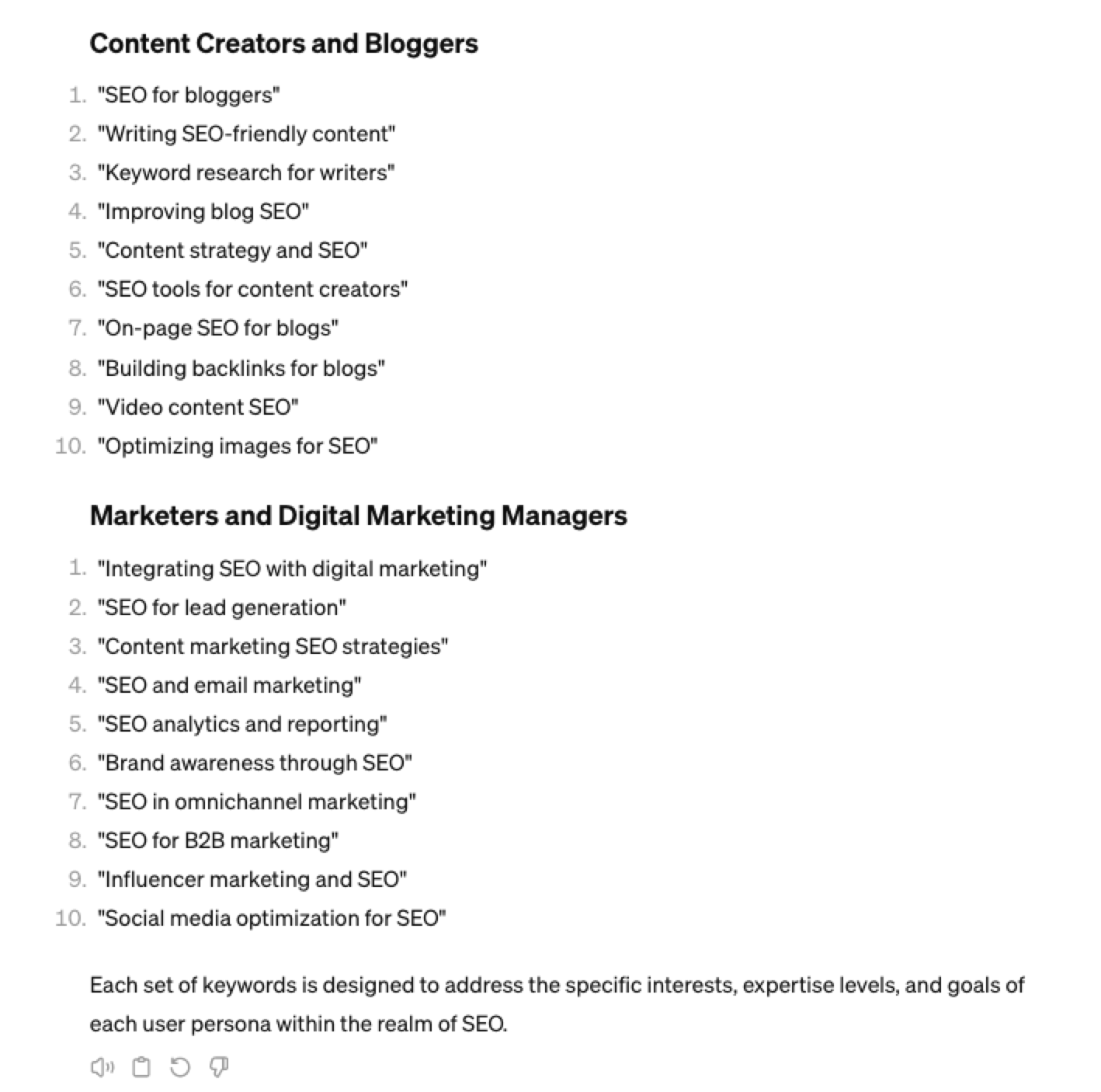 Screenshot from ChatGPT 4, April 2024
Screenshot from ChatGPT 4, April 2024You could even go a step further and ask for questions based on those topics that those specific user personas may be searching for:
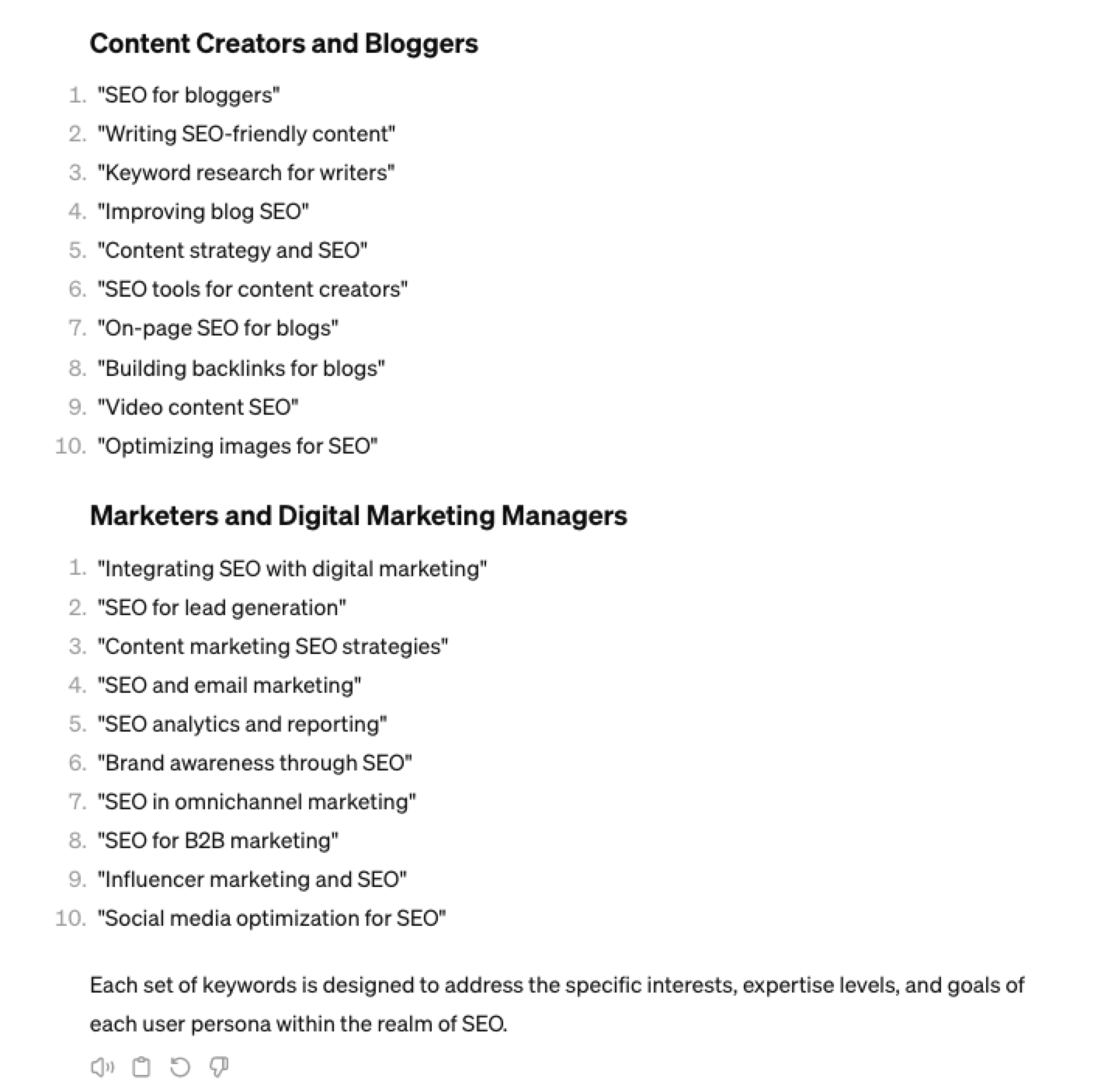 Screenshot ChatGPT 4, April 2024
Screenshot ChatGPT 4, April 2024As well as get the keywords to target based on those questions:
“For each question listed above for each persona, list the keywords, as well as the long-tail keywords to target, and put them in a table”
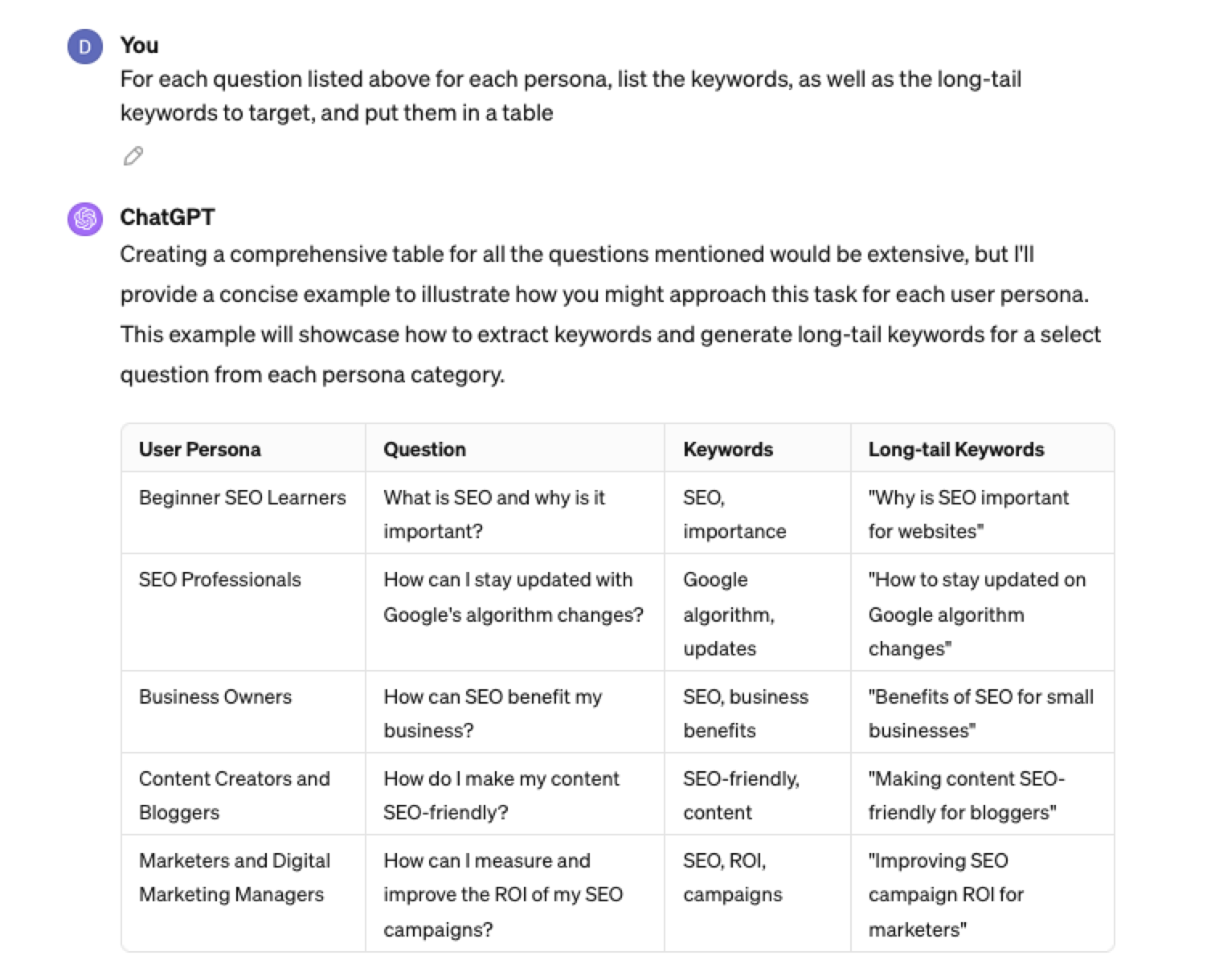 Screenshot from ChatGPT 4, April 2024
Screenshot from ChatGPT 4, April 2024Generating Keyword Ideas Using ChatGPT Based On Searcher Intent And User Personas
Understanding the keywords your target persona may be searching is the first step to effective keyword research. The next step is to understand the search intent behind those keywords and which content format may work best.
For example, a business owner who is new to SEO or has just heard about it may be searching for “what is SEO.”
However, if they are further down the funnel and in the navigational stage, they may search for “top SEO firms.”
You can query ChatGPT to inspire you here based on any topic and your target user persona.
SEO Example:
“For the topic of “{Topic}” list 10 keywords each for the different types of searcher intent that a {Target Persona} would be searching for”
ChatGPT For Keyword Research Admin
Here is how you can best use ChatGPT for keyword research admin tasks.
Using ChatGPT As A Keyword Categorization Tool
One of the use cases for using ChatGPT is for keyword categorization.
In the past, I would have had to devise spreadsheet formulas to categorize keywords or even spend hours filtering and manually categorizing keywords.
ChatGPT can be a great companion for running a short version of this for you.
Let’s say you have done keyword research in a keyword research tool, have a list of keywords, and want to categorize them.
You could use the following prompt:
“Filter the below list of keywords into categories, target persona, searcher intent, search volume and add information to a six-column table: List of keywords – [LIST OF KEYWORDS], Keyword Search Volume [SEARCH VOLUMES] and Keyword Difficulties [KEYWORD DIFFICUTIES].”
-
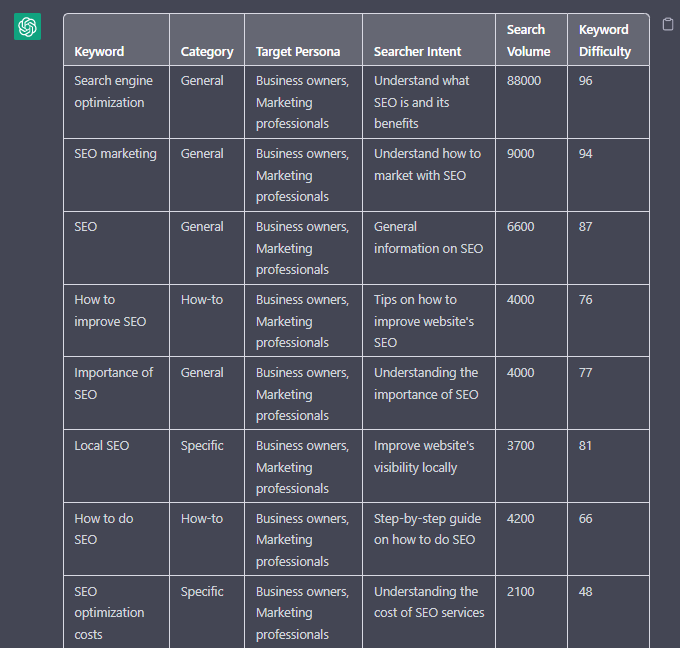 Screenshot from ChatGPT, April 2024
Screenshot from ChatGPT, April 2024
Tip: Add keyword metrics from the keyword research tools, as using the search volumes that a ChatGPT prompt may give you will be wildly inaccurate at best.
Using ChatGPT For Keyword Clustering
Another of ChatGPT’s use cases for keyword research is to help you cluster. Many keywords have the same intent, and by grouping related keywords, you may find that one piece of content can often target multiple keywords at once.
However, be careful not to rely only on LLM data for clustering. What ChatGPT may cluster as a similar keyword, the SERP or the user may not agree with. But it is a good starting point.
The big downside of using ChatGPT for keyword clustering is actually the amount of keyword data you can cluster based on the memory limits.
So, you may find a keyword clustering tool or script that is better for large keyword clustering tasks. But for small amounts of keywords, ChatGPT is actually quite good.
A great use small keyword clustering use case using ChatGPT is for grouping People Also Ask (PAA) questions.
Use the following prompt to group keywords based on their semantic relationships. For example:
“Organize the following keywords into groups based on their semantic relationships, and give a short name to each group: [LIST OF PAA], create a two-column table where each keyword sits on its own row.
-
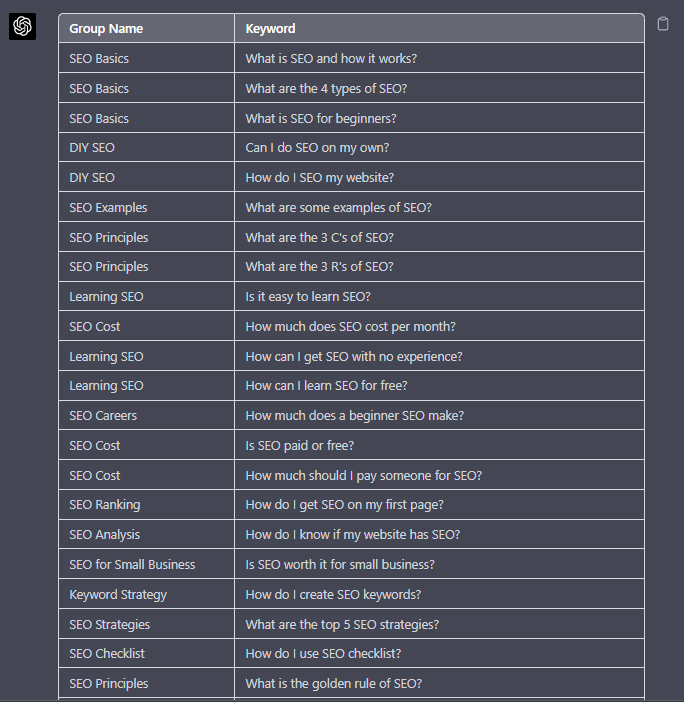 Screenshot from ChatGPT, April 2024
Screenshot from ChatGPT, April 2024
Using Chat GPT For Keyword Expansion By Patterns
One of my favorite methods of doing keyword research is pattern spotting.
Most seed keywords have a variable that can expand your target keywords.
Here are a few examples of patterns:
1. Question Patterns
(who, what, where, why, how, are, can, do, does, will)
“Generate [X] keywords for the topic “[Topic]” that contain any or all of the following “who, what, where, why, how, are, can, do, does, will”
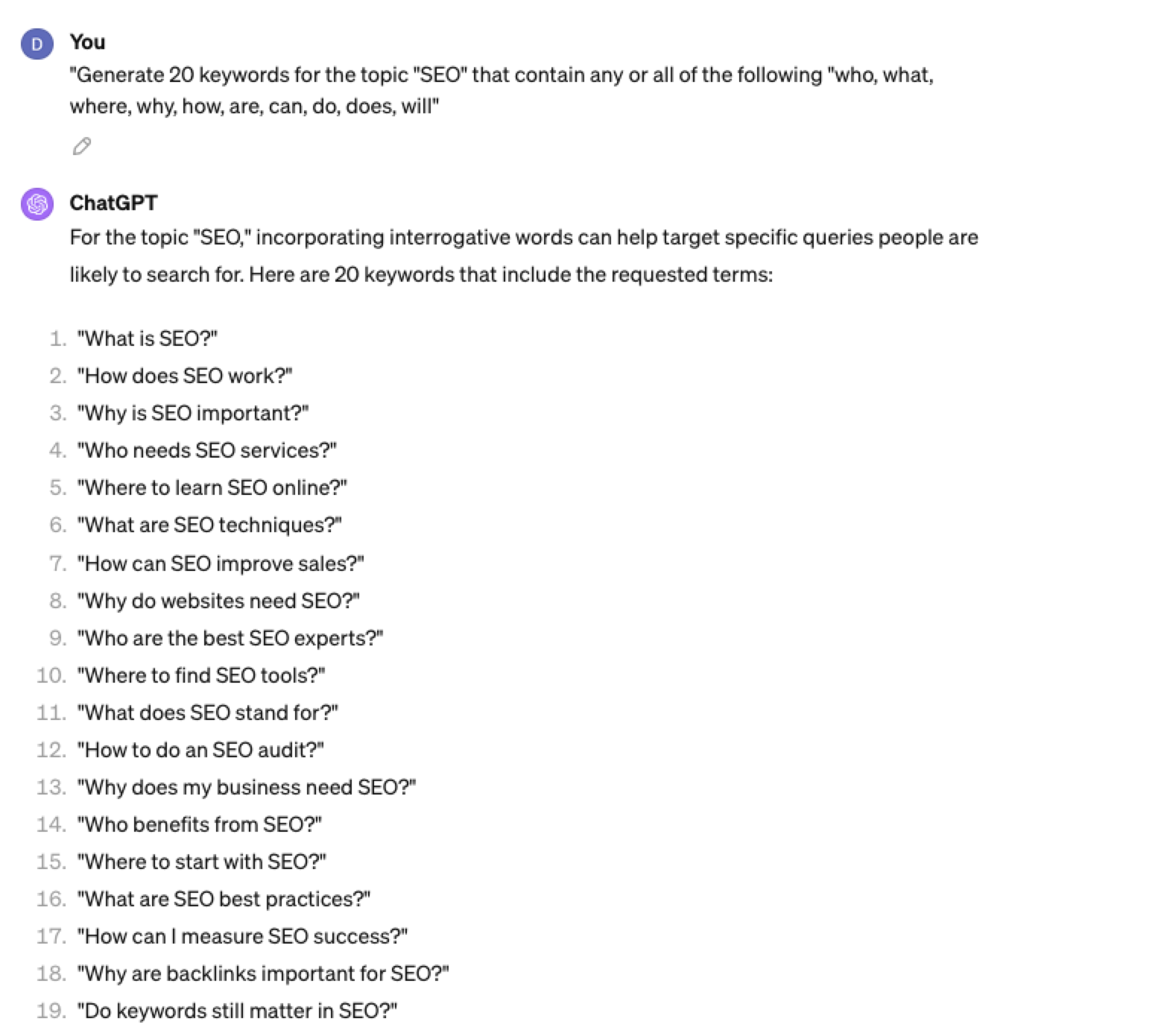 Screenshot ChatGPT 4, April 2024
Screenshot ChatGPT 4, April 20242. Comparison Patterns
Example:
“Generate 50 keywords for the topic “{Topic}” that contain any or all of the following “for, vs, alternative, best, top, review”
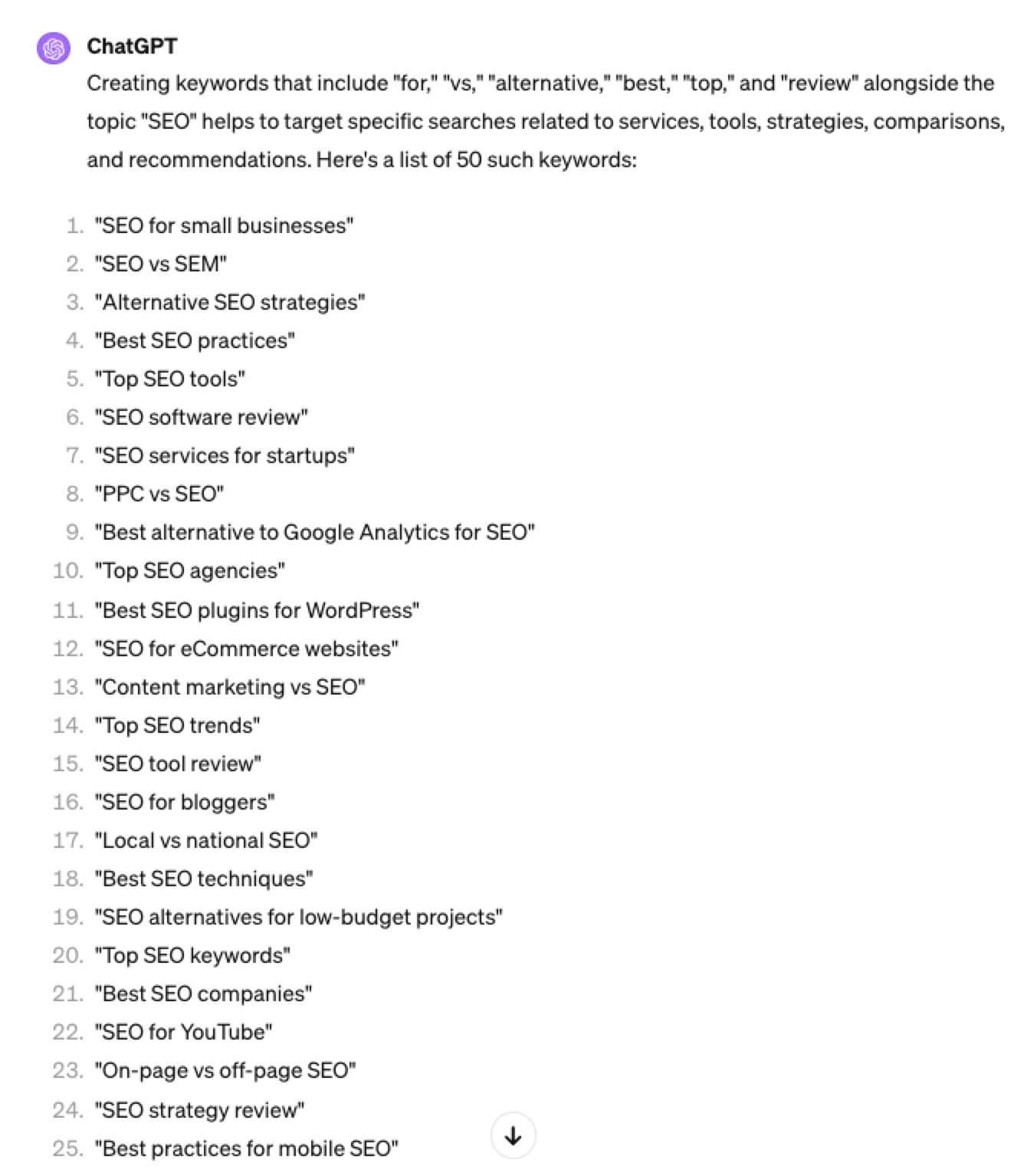 Screenshot ChatGPT 4, April 2024
Screenshot ChatGPT 4, April 20243. Brand Patterns
Another one of my favorite modifiers is a keyword by brand.
We are probably all familiar with the most popular SEO brands; however, if you aren’t, you could ask your AI friend to do the heavy lifting.
Example prompt:
“For the top {Topic} brands what are the top “vs” keywords”
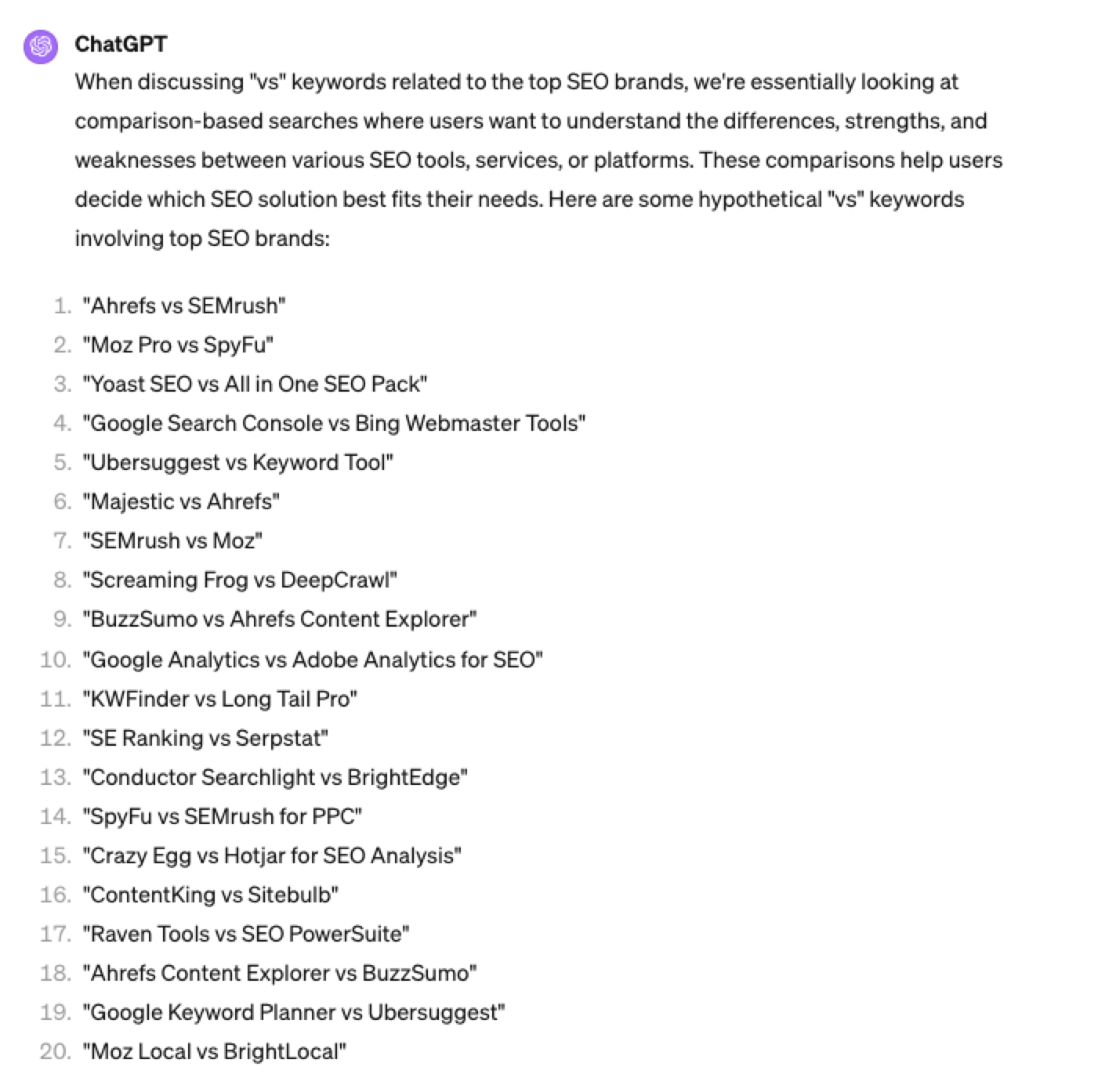 Screenshot ChatGPT 4, April 2024
Screenshot ChatGPT 4, April 20244. Search Intent Patterns
One of the most common search intent patterns is “best.”
When someone is searching for a “best {topic}” keyword, they are generally searching for a comprehensive list or guide that highlights the top options, products, or services within that specific topic, along with their features, benefits, and potential drawbacks, to make an informed decision.
Example:
“For the topic of “[Topic]” what are the 20 top keywords that include “best”
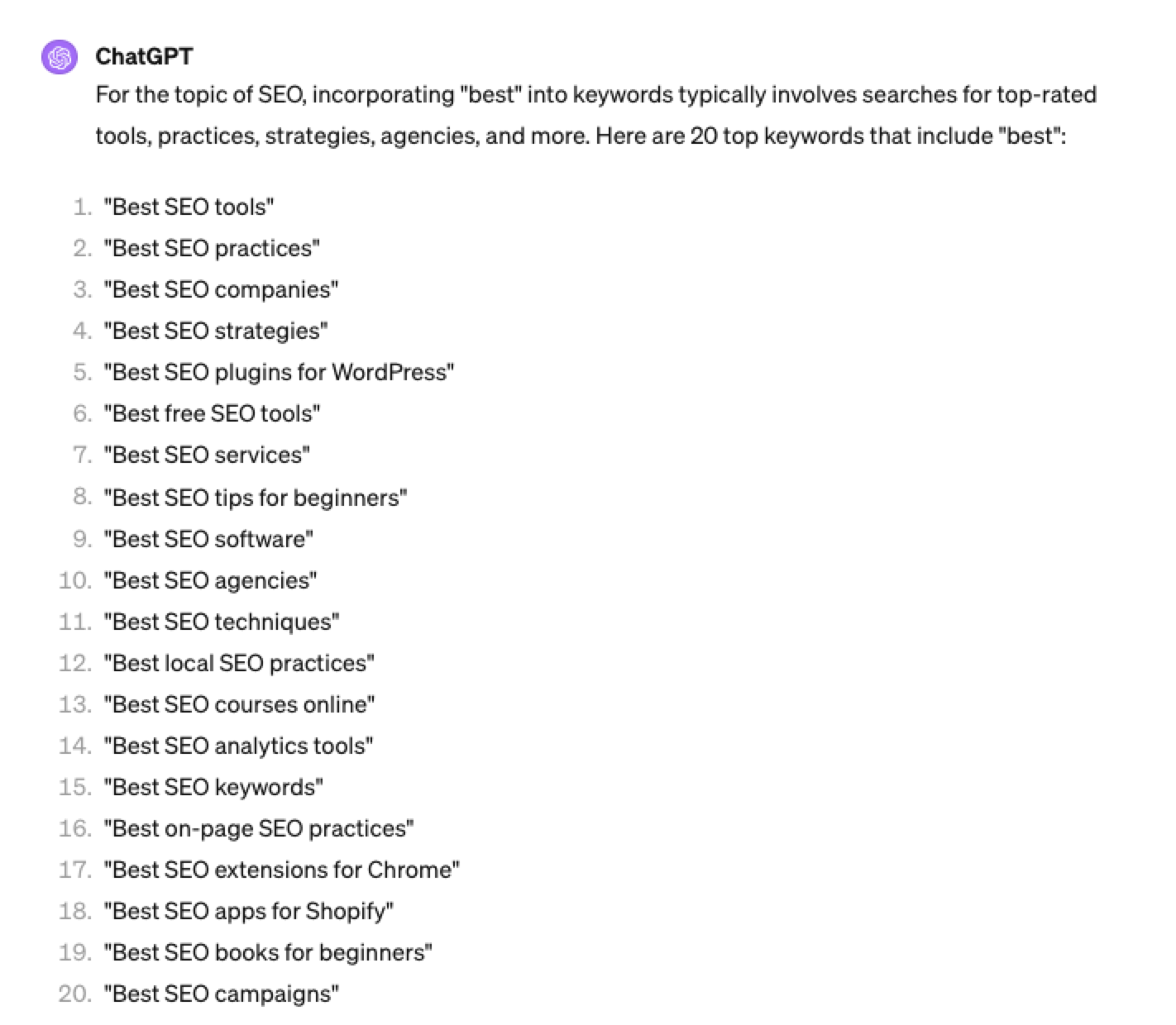 Screenshot ChatGPT 4, April 2024
Screenshot ChatGPT 4, April 2024Again, this guide to keyword research using ChatGPT has emphasized the ease of generating keyword research ideas by utilizing ChatGPT throughout the process.
Keyword Research Using ChatGPT Vs. Keyword Research Tools
Free Vs. Paid Keyword Research Tools
Like keyword research tools, ChatGPT has free and paid options.
However, one of the most significant drawbacks of using ChatGPT for keyword research alone is the absence of SEO metrics to help you make smarter decisions.
To improve accuracy, you could take the results it gives you and verify them with your classic keyword research tool – or vice versa, as shown above, uploading accurate data into the tool and then prompting.
However, you must consider how long it takes to type and fine-tune your prompt to get your desired data versus using the filters within popular keyword research tools.
For example, if we use a popular keyword research tool using filters, you could have all of the “best” queries with all of their SEO metrics:
-
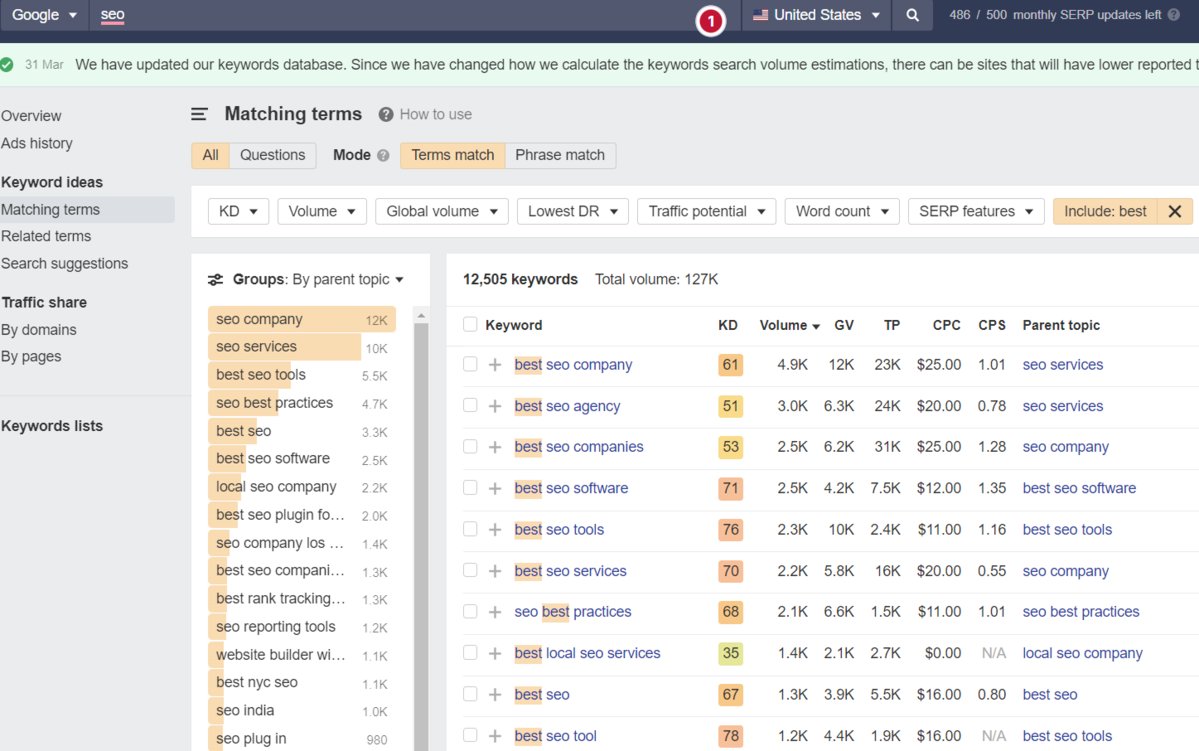 Screenshot from Ahrefs Keyword Explorer, March 2024
Screenshot from Ahrefs Keyword Explorer, March 2024
And unlike ChatGPT, generally, there is no token limit; you can extract several hundred, if not thousands, of keywords at a time.
As I have mentioned multiple times throughout this piece, you cannot blindly trust the data or SEO metrics it may attempt to provide you with.
The key is to validate the keyword research with a keyword research tool.
ChatGPT For International SEO Keyword Research
ChatGPT can be a terrific multilingual keyword research assistant.
For example, if you wanted to research keywords in a foreign language such as French. You could ask ChatGPT to translate your English keywords;
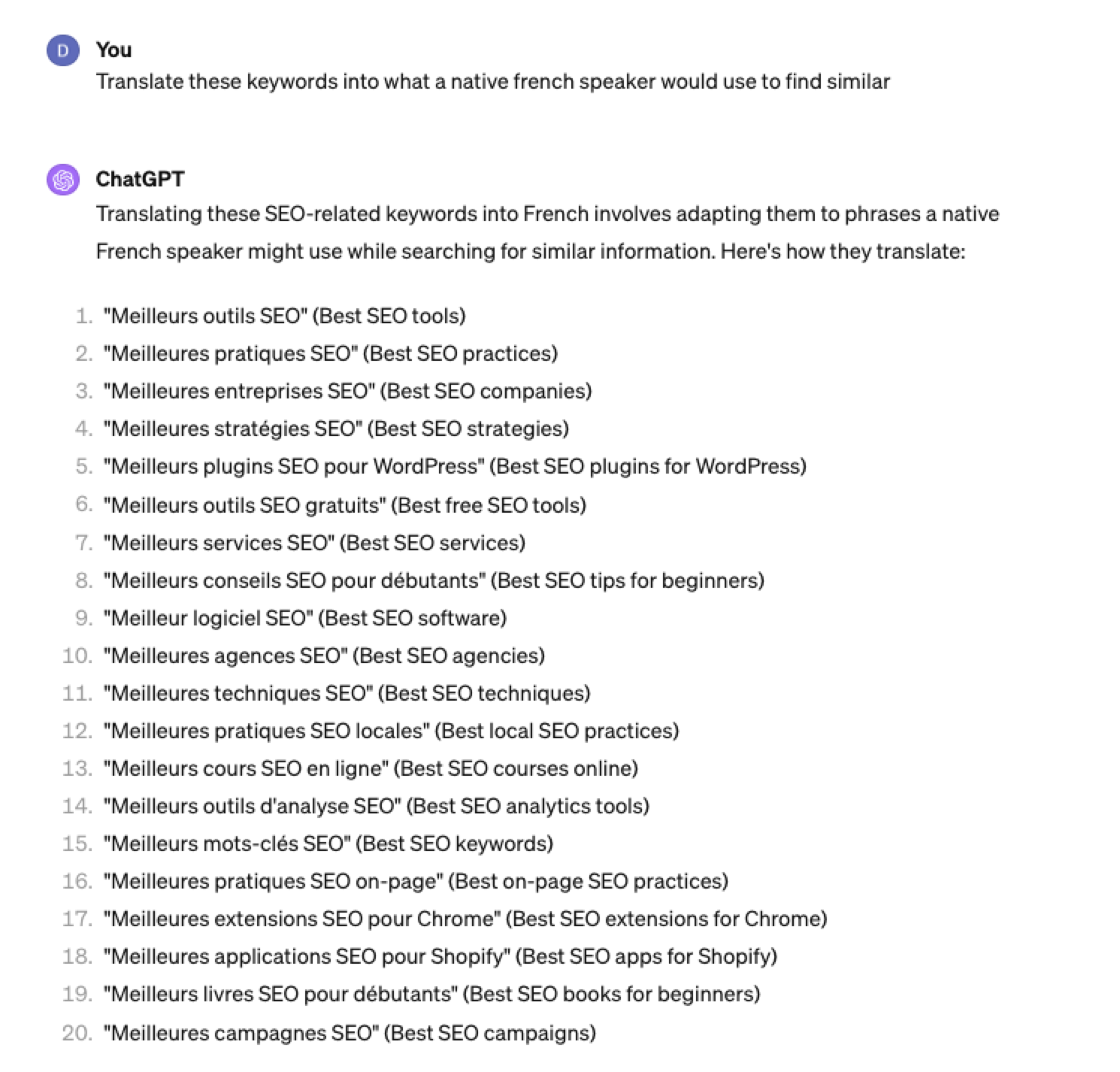 Screenshot ChatGPT 4, Apil 2024
Screenshot ChatGPT 4, Apil 2024- The key is to take the data above and paste it into a popular keyword research tool to verify.
- As you can see below, many of the keyword translations for the English keywords do not have any search volume for direct translations in French.
 Screenshot from Ahrefs Keyword Explorer, April 2024
Screenshot from Ahrefs Keyword Explorer, April 2024But don’t worry, there is a workaround: If you have access to a competitor keyword research tool, you can see what webpage is ranking for that query – and then identify the top keyword for that page based on the ChatGPT translated keywords that do have search volume.
-
-
 Screenshot from Ahrefs Keyword Explorer, April 2024
Screenshot from Ahrefs Keyword Explorer, April 2024
Or, if you don’t have access to a paid keyword research tool, you could always take the top-performing result, extract the page copy, and then ask ChatGPT what the primary keyword for the page is.
Key Takeaway
-
ChatGPT can be an expert on any topic and an invaluable keyword research tool. However, it is another tool to add to your toolbox when doing keyword research; it does not replace traditional keyword research tools.
As shown throughout this tutorial, from making up keywords at the beginning to inaccuracies around data and translations, ChatGPT can make mistakes when used for keyword research.
You cannot blindly trust the data you get back from ChatGPT.
However, it can offer a shortcut to understanding any topic for which you need to do keyword research and, as a result, save you countless hours.
But the key is how you prompt.
The prompts I shared with you above will help you understand a topic in minutes instead of hours and allow you to better seed keywords using keyword research tools.
It can even replace mundane keyword clustering tasks that you used to do with formulas in spreadsheets or generate ideas based on keywords you give it.
Paired with traditional keyword research tools, ChatGPT for keyword research can be a powerful tool in your arsenal.
More resources:
Featured Image: Tatiana Shepeleva/Shutterstock
-

 PPC6 days ago
PPC6 days agoHow the TikTok Algorithm Works in 2024 (+9 Ways to Go Viral)
-

 SEO7 days ago
SEO7 days agoBlog Post Checklist: Check All Prior to Hitting “Publish”
-
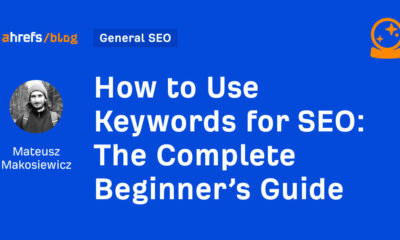
 SEO5 days ago
SEO5 days agoHow to Use Keywords for SEO: The Complete Beginner’s Guide
-

 MARKETING6 days ago
MARKETING6 days agoHow To Protect Your People and Brand
-

 SEARCHENGINES7 days ago
SEARCHENGINES7 days agoGoogle Started Enforcing The Site Reputation Abuse Policy
-

 PPC7 days ago
PPC7 days agoHow to Craft Compelling Google Ads for eCommerce
-

 MARKETING7 days ago
MARKETING7 days agoElevating Women in SEO for a More Inclusive Industry
-

 PPC7 days ago
PPC7 days agoHow to Brainstorm Business Ideas: 9 Fool-Proof Approaches






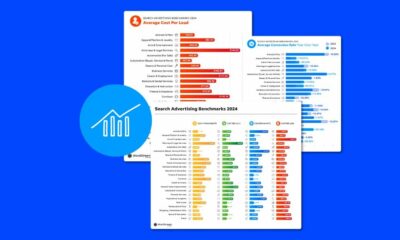

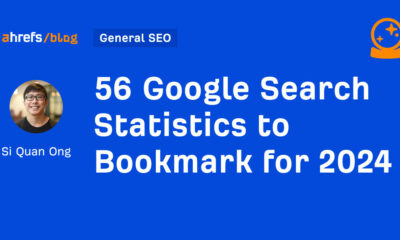







You must be logged in to post a comment Login